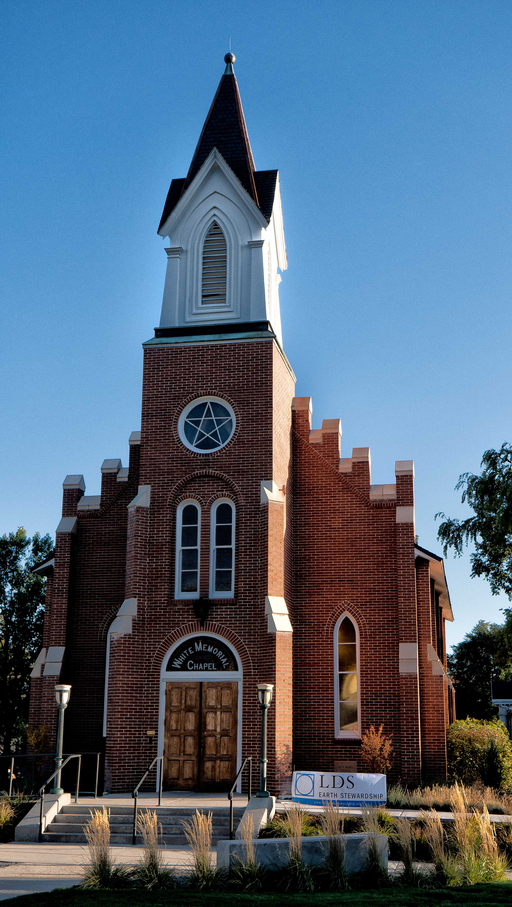In November we held our annual Fall Forum at BYU, Provo. It was a fascinating presentation given by Dr. Paul Alan Cox.
Dr. Cox has lived in remote island villages searching for new medicines. He was awarded the Goldman Environmental Prize, sometimes known as the Nobel Prize of the Environment and was named one of TIME magazine’s eleven “Heroes of Medicine” for his discovery of a new HIV drug candidate.
His conservation foundation, Seacology, has set aside over 1.5 million acres of rain forest and coral reef in 60 countries around the world.
Cox was both a Danforth Fellow and a National Science Foundation Fellow at Harvard where he received his Ph.D. He currently serves as the Executive Director of the Brain Chemistry Labs in Jackson, Wyoming, a not-for-profit research institute focused on finding new treatments for ALS and Alzheimer’s disease. Below, we include the video recording from our YouTube Channel and the transcript:
Dr, Cox:
Many thanks to Professor Oscarson and the generous, overly generous introduction. Thanks Professor Hanley and Serena and some former students and even a dear friend of mine from boy hood, Jim Dain: great to have you here.
I’d like to talk tonight about the Creation and focus on three elements. I’d like to talk about the stars; the plants; and people. Then I’d like to argue how that could be a basis for a conservation ethic by disciples of our Savior as well as some unique capabilities we have in providing leadership to a world that so desperately needs it on these issues right now.
It’s striking to me the emphasis that is given to the Creation in teaching the gospel. We hear about the Creation over and over. The Book of Genesis portrays an orderly sequence, the creation of heavens and Earth, but it appears that that book may be a redacted version of a more detailed account given to Moses we have fragments of in the Pearl of Great Price. The Pearl of Great Price also recounts the panorama of creation as revealed to Abraham.
We repeatedly hear the details of this creation in sacred places. The importance of that creation is made clear in the Book of Mormon. When Lehi received the brass plates out in the desert, he looked at them and “beheld they contained the five books of Moses which gave an account of the creation of the world and also of Adam and Eve who were our first parents” (1 Nephi 5:11). Later, as Ammon and his compatriots took a missionary journey to the sworn enemies of the Nephites, Ammon, because of his faithfulness was given the opportunity to teach King Lamoni: "He began at the creation of the world and also the creation of Adam (Alma 18:36). This practice of teaching about the creation was continued by his companion Aaron who subsequently taught King Lamoni’s father (Alma 22:12). I’d like to suggest that those two events changed the hearts of an entire nation. In fact, the Book of Mormon in so many ways is a manual of missionary work to political elites. The Jaredite plates translated by King Mosiah through the gift of God included an account of creation (Mosiah 28:17; Ether 1:3). At the end of the Book of Mormon, Moroni’s final exhortation to readers of that book encourages them to remember “how merciful the Lord has been to the children of men, from the creation of Adam even down until the time they shall receive these things and to ponder it in your hearts” (Moroni 10:3). We have frequent reminders in our sacred ordinances and in the scriptures and in the writings of the living prophets that we should be aware and think about the Creation. What can we learn by pondering the Creation as portrayed in the scriptures and in the temple?
I suggest there are three important principles that emerge from all these accounts of the creation. First of all, that the Earth and the entire universe was created by a loving Heavenly Father. Secondly, that the plants and animals we share this Earth with are important to Him. The Lord refers to them in modern revelation as “my creatures” (D&C 104:13). And third, that all human beings are children of God and of divine provenance.
It follows from these three principles that reverence towards the Creation reflects reverence and respect for the Creator. Since we are surrounded continuously by the handiwork of God, conservation can be transformed into an act of worship. So I would like to briefly consider the stars, the planets, and our fellow human beings that we share this planet with. I will conclude with a few examples of conservation that represent personal acts of worship.
So first of all, the stars. This is my home in Jackson Hole, Wyoming. Just when we left Friday night to come down here, I called Barbara outside to look at the stars, which burned so brightly in the night sky.
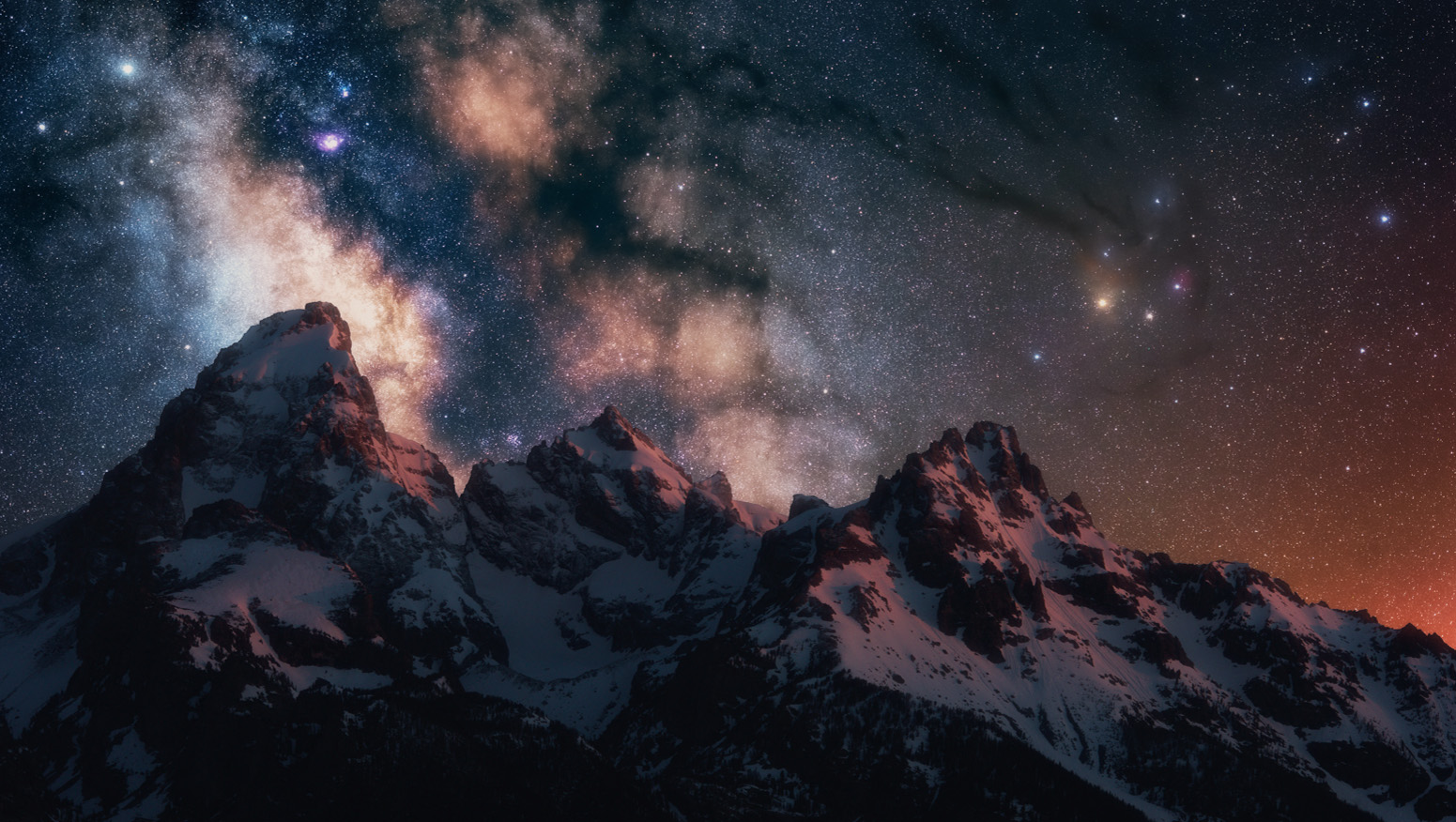
I had a friend, a dear friend, from Japan who visited and when I took her and showed her the stars outside the little ranch we live on, she started weeping. I said “why are you weeping?” and she said “I’ve never seen the Milky Way before”. I asked “you never looked up?” She said “I’ve lived my entire life in Tokyo, I haven’t seen the stars”.
Have you ever gazed at the stars at night? Ralph Waldo Emerson wrote, “if the stars should appear one night in a thousand, how would men believe and adore and preserve for many generations the remembrance of the city of God which had been shown!”
In the Psalms, David said “When I consider thy heavens, the work of thy fingers, the moon and the stars which thou hast ordained, what is man that thou art mindful of him? and the son of man that thou visited him?” (Psalms 8:34).
As a young missionary, my theory in those days was that at the church office building workers would assemble the applications and photographs of those seeking to be called on a mission. Most could go anywhere, perhaps a few applicants would be sent back to their bishop to get a haircut or whatever. However, there were likely a very few mission applicants that they couldn’t figure out where to hide them so they wouldn’t embarrass the church. That’s probably the pile my application fell into. The same process, I’m sure, was repeated in Samoa. They took one look at me and dispatched me to the most remote island, the most remote village, in the mission-- a place that filled the heart of every Samoan missionary with terror -- and then forgot about me. I was in heaven for about six months.
So as a young missionary, posted to a remote island in the Samoan archipelago, I was stunned by the brightness of the stars at night. I used to hear the elderly chiefs name the stars. They were used anciently in navigating their ocean-going craft across the vast expanses of the Pacific Ocean. The chiefs taught me to gracefully end the nighttime engagement by quoting the proverb “Ua lata mai le fetu o Leapai ma lana nofoaga”. (“The star of Leapai and his constellation will soon arise).

Alma used the wonder of the night sky to refute Korihor’s atheistic preaching by testifying that “all things denote there is a God, yea even the earth and all things upon the face of it, yea and its motion and also all the planets which move in regular form do witness that there is a supreme creator.” (Alma 30:44).
Have you ever tried to count the stars? Have you ever wondered how many stars there are? Astronomers estimate that our own galaxy, the Milky Way, contains about 100 million stars. How many galaxies are there?
This photo is from the Hubble space telescope, the deep view of space. Every one of those objects you see is a galaxy.
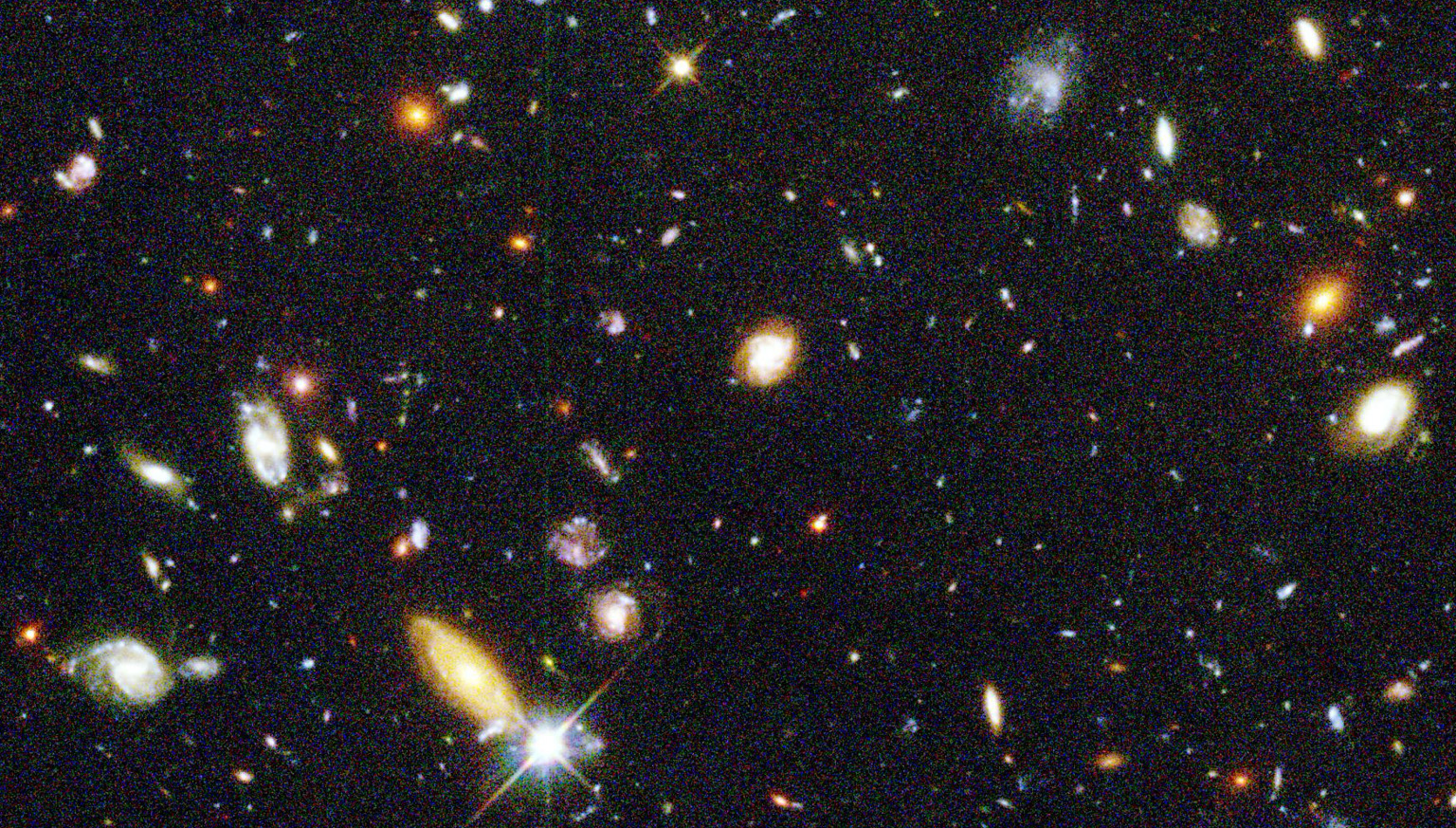
If you held a match at arm’s length up to the sky and saw what was obscured by the matchhead, that would correspond to the amount of space that appears in this Hubble photo. Observations from the deep view of the Hubble space telescope suggest that there are about 200 billion galaxies in our universe. However, newer research suggests that estimate is ten times too small. In other words, there are at least two trillion galaxies in our universe. If our galaxy and Milky Way is any indication, that means there are two million trillion stars in our universe. Two million trillion stars.
Thus there are more stars in the heavens than the number of grains of sand on every beach, and in every desert on the Earth. Many, many more. Next time you let sand sift through your hand, think of each grain as a different star. You could process all the sand in the world, assigning a different star to every grain, and never run out of new stars.
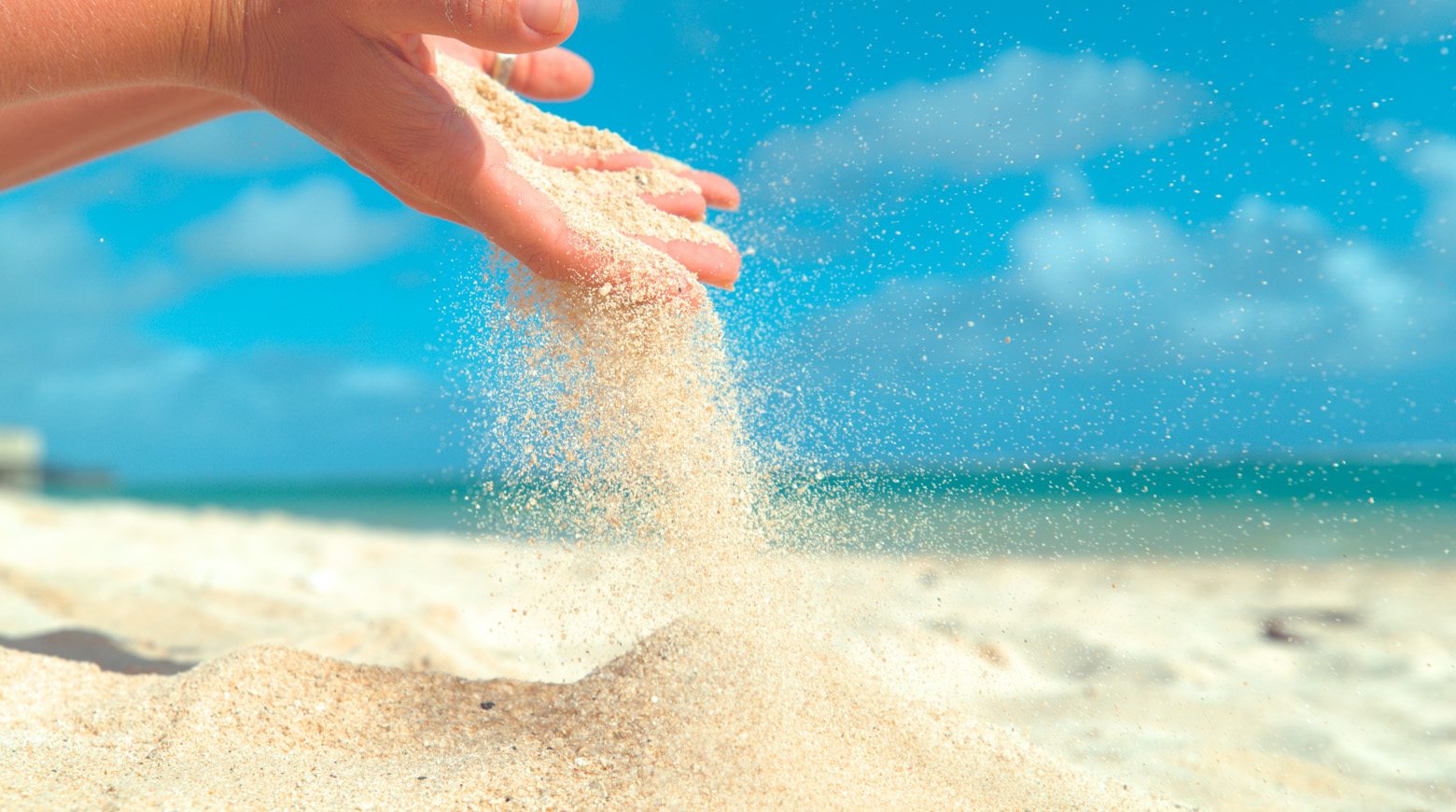
As Abraham recounted when the Lord showed him the stars, “He put his hand on my eyes and I saw those things which his hands had made, which were many; and they multiplied before mine eyes, and I could not see the end thereof (Abraham 3:12).
An even greater number of planets orbit many of those stars. The Lord said to Moses “And worlds without number have I created, and I also created them for mine own purpose; and by the Son I created them, which is mine Only Begotten” (Moses 1:33).
None of this was known to science in the 1830s when the book of Moses and the book of Abraham were revealed to the prophet Joseph Smith. Before 1923, scientists did not know of any other galaxy in the universe other than our own Milky Way.
Before 1988 astronomers had not detected any planets outside of our solar system. The initial detection of a single exoplanet was confirmed in 1992. Quoting from a 2021 article that just appeared in Physical Review Letters, “almost all exoplanets we now know were only discovered in the last decade with the majority found in the last five years.” The authors state that there are 4,324 confirmed exoplanets and an additional 5,695 candidates under review. They estimate there are an additional 300 billion exoplanets in our galaxy alone.
As the prophet Enoch expressed, “And were it possible that man could number the particles of the earth, yea, millions of earths like this, it would not be a beginning to the number of thy creations” (Moses 7: 30)
We’re taught that Heavenly Father created the universe through his Son, Jesus Christ. Writing of this, the apostle Paul explained to the Colossians, “For by him were all things created, that are in heaven, and that are in earth, visible and invisible, whether they be thrones, or dominions, or principalities, or powers: all things were created by him, and for him:” (Colossians 1:16).
The vastness of creation extends not only in space but also in time. As we gaze through space telescopes at the most distant galaxy that is observable, we’re actually looking back into deep time, near the beginning of the universe. Our universe appears to be 13.8 billion years old. The heavier elements in our planet, the gold in my wedding ring, or the platinum in the catalytic converters in our cars did not come from our sun.
At this point, our sun is only hot enough to fuse hydrogen to produce helium.
Instead, these elements must have come from fusion reactions far hotter than our sun, likely from a supernova explosion.
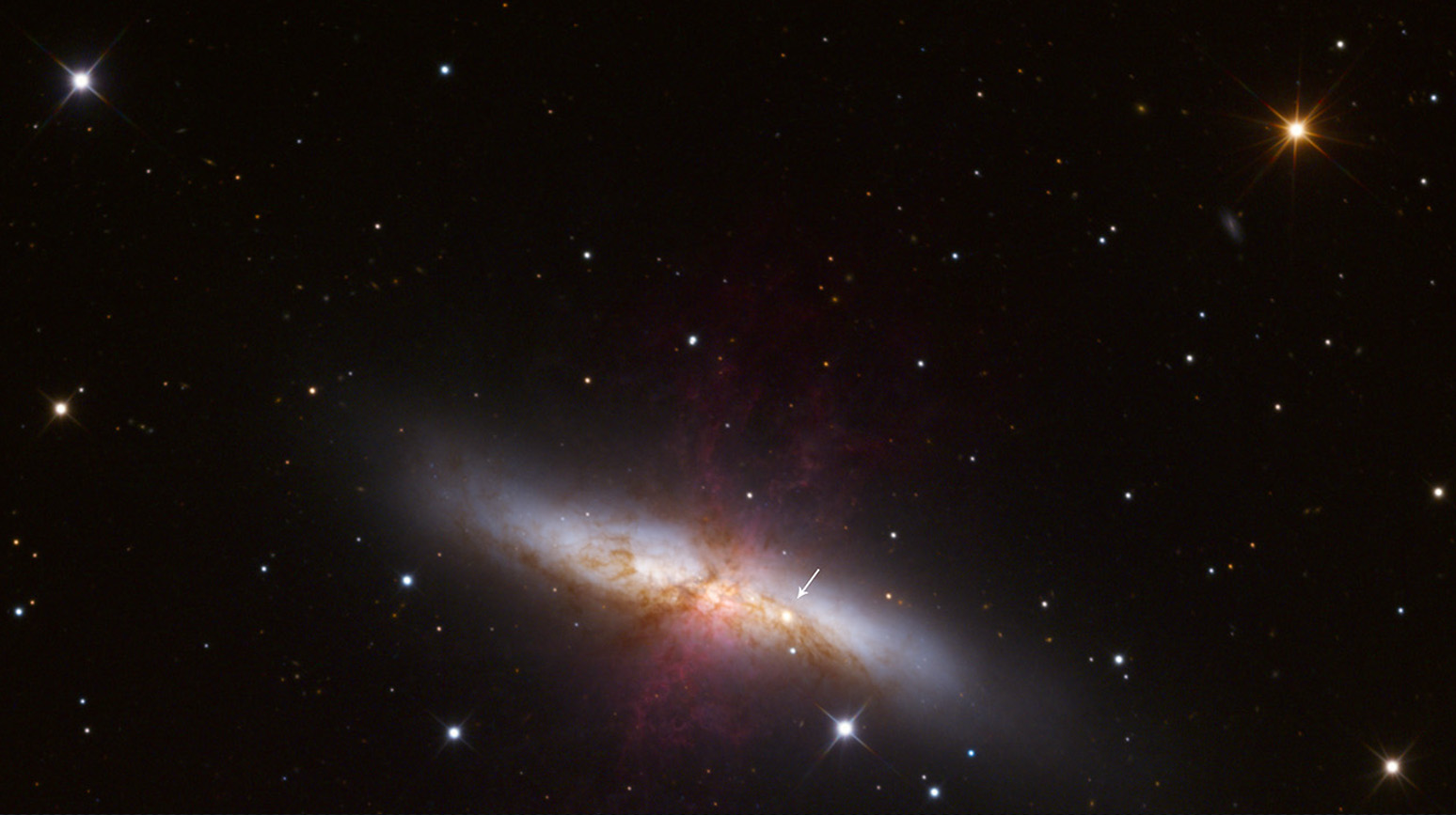
This type of supernova explosion was first detected by scientists on August 17, 2017. They carefully monitor laser beams at the LIGO observatories in Hanford Washington and Livingston, Louisiana, while the Italians near Pisa monitored laser beams at the Virgo Observatory. Basically they’re measuring laser beams that stretch over kilometers to see if there’s an infinitesimal diversion of the beam from its course. On October 17, 2017, they simultaneously detected the pulse of gravitational waves from the collision of two neutron stars. Because they were able to triangulate, from the three laser beams they were able to get optical confirmation from the telescopes both in space and down in Chile. The nuclear fusion that was ignited by the collision of those two neutron stars was so hot that it produced a large dust cloud of gold and many other heavy elements not produced by our sun.
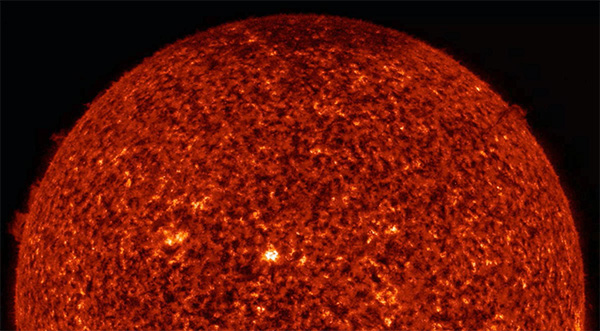
So even though as primary children, we sing that we are sunbeams, The composition of our bodies has little to do with the helium produced by the young star our planet orbits. Instead, we are composed of stardust. It appears that the sun and the Earth were formed around 5 billion years ago from dust and ejecta from a supernova explosion. Perhaps this is what Elder Russell Ballard referred to as “matter unorganized.” Joni Mitchell had it right: we are stardust.
In the cosmic time scale, our sun and the Earth are of similar age. It’s possible that the Earth may have been solidified before intense gravitational forces ignited the fusion furnace of the sun and perhaps even possible that the sun was not ignited before the moon was knocked off through a planetary collision. If so, imagine what the first light from that newest of stars, our sun, reflected from a previously darkened moon, must have looked like.
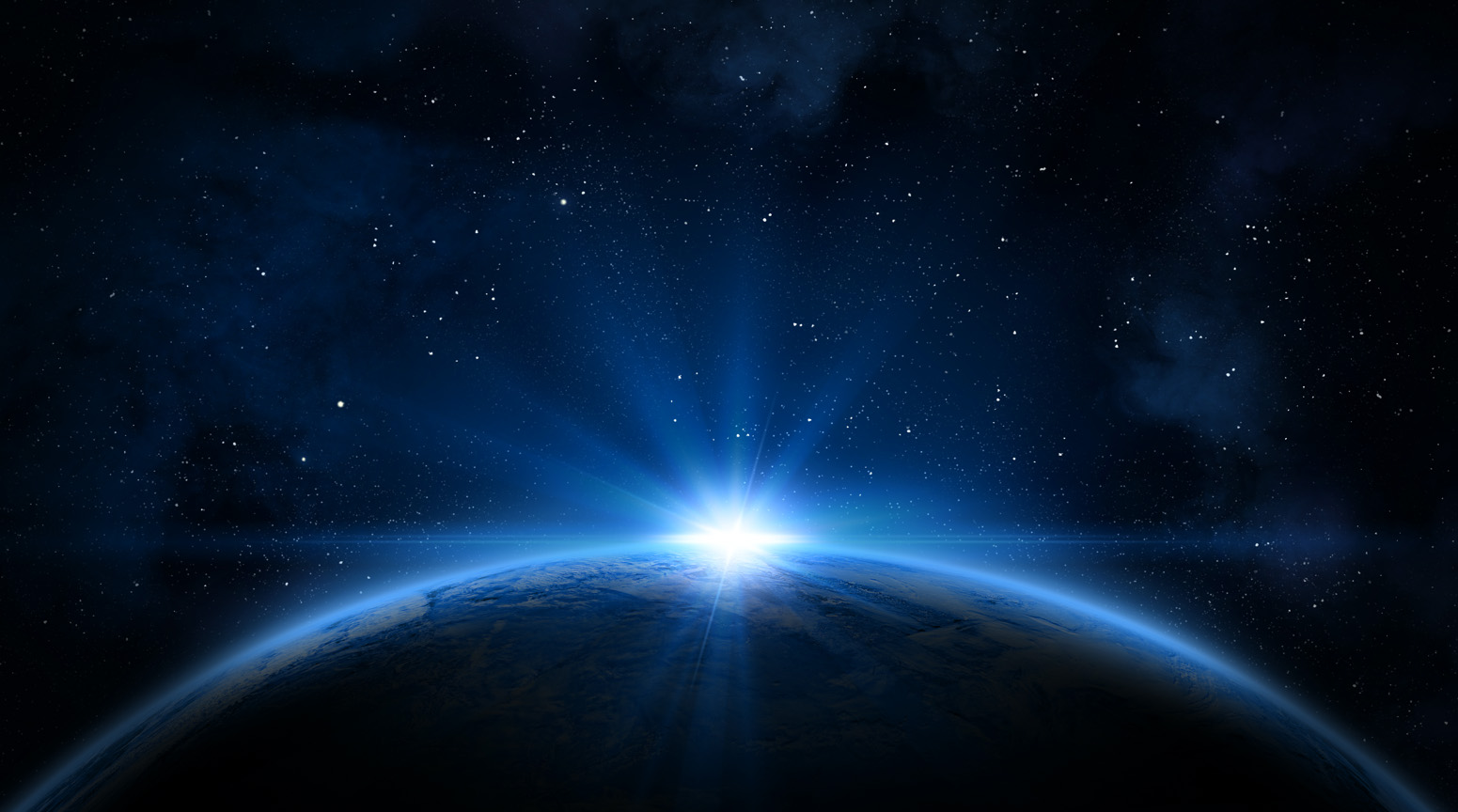
As the Lord taught Abraham:
“And the earth after it was formed was empty and desolate because they had not formed anything but the earth and darkness reigned upon the face of the deep; and the Spirit of the Gods was brooding upon the face of the waters. And they (the Gods) said: Let there be light; and there was light.” (Abraham 4:2-3)
The majesty of creation can also be seen at the macro level. In fact, he who created the stars and the galaxies is aware of the fall of a single sparrow (Matthew 10:29). Jesus taught his disciples:
“Consider the lilies how they grow: they toil not, they spin not; and yet I say unto you, that Solomon in all his glory was not arrayed like one of these. (Luke 12:27)
This photo is of Kungsängslilja in Uppsala, Sweden named after the king.

The Savior, of course, was likely trying to encourage his disciples not to allow temporal concerns to interfere with their apostolic callings. I suggest however, that His admonition to consider how lilies grow since they toil not, they spin not, and yet produce a glory which exceeds that of Solomon bears further scientific consideration.
This is a photograph I took in the San Rafael Swell, Utah of one of the most endangered species on planet Earth.
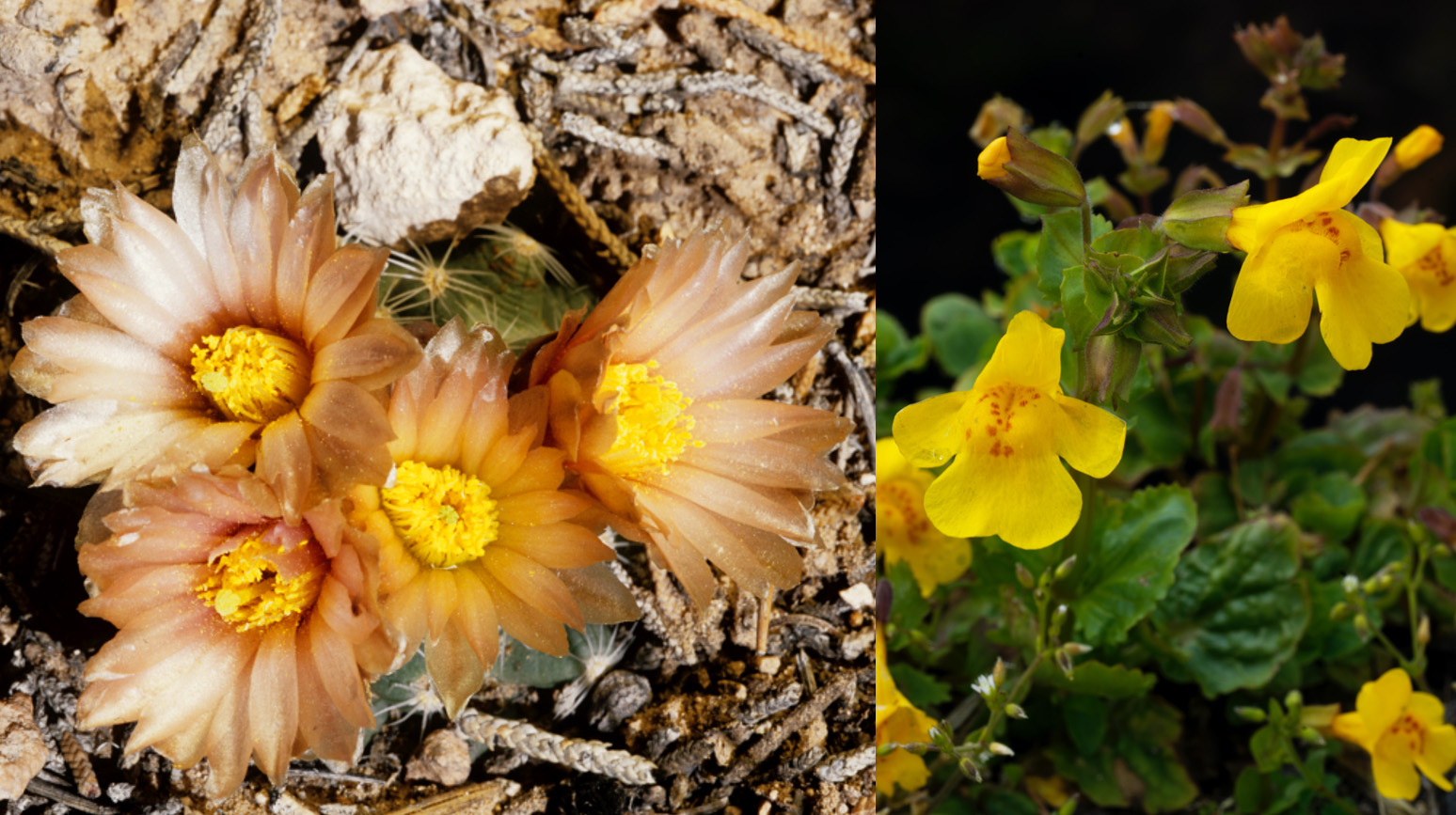
Pediocactus despainii spends its entire life underground and then right around Easter pops up and flower and then retreats. The next photo is of a Mimulus monkey flower that Barbara and I photographed teetering on the edge of a fumarole at a geyser in Yellowstone National Park.
In 1648, Jan Baptista van Helmont, a Flemish biologist, performed a simple but elegant experiment that has profound implications for our modern age, particularly while there is a meeting this week of the world’s nations in Glasgow on climate change. He planted a five-pound willow and 200 pounds of soil. He let it grow five years. He then removed the flourishing plant from the soil and found it to weigh 169 lbs 3 oz. He then weighed the soil and found that the soil weighed 199 lbs 14 oz. In other words, what von Helmont found that only two ounces of soil produced a 164 pounds 3 oz of willow. If we exclude the mass of water, we’re still left with most of the willow. Two oz of soil produced that massive willow, that’s what he found.
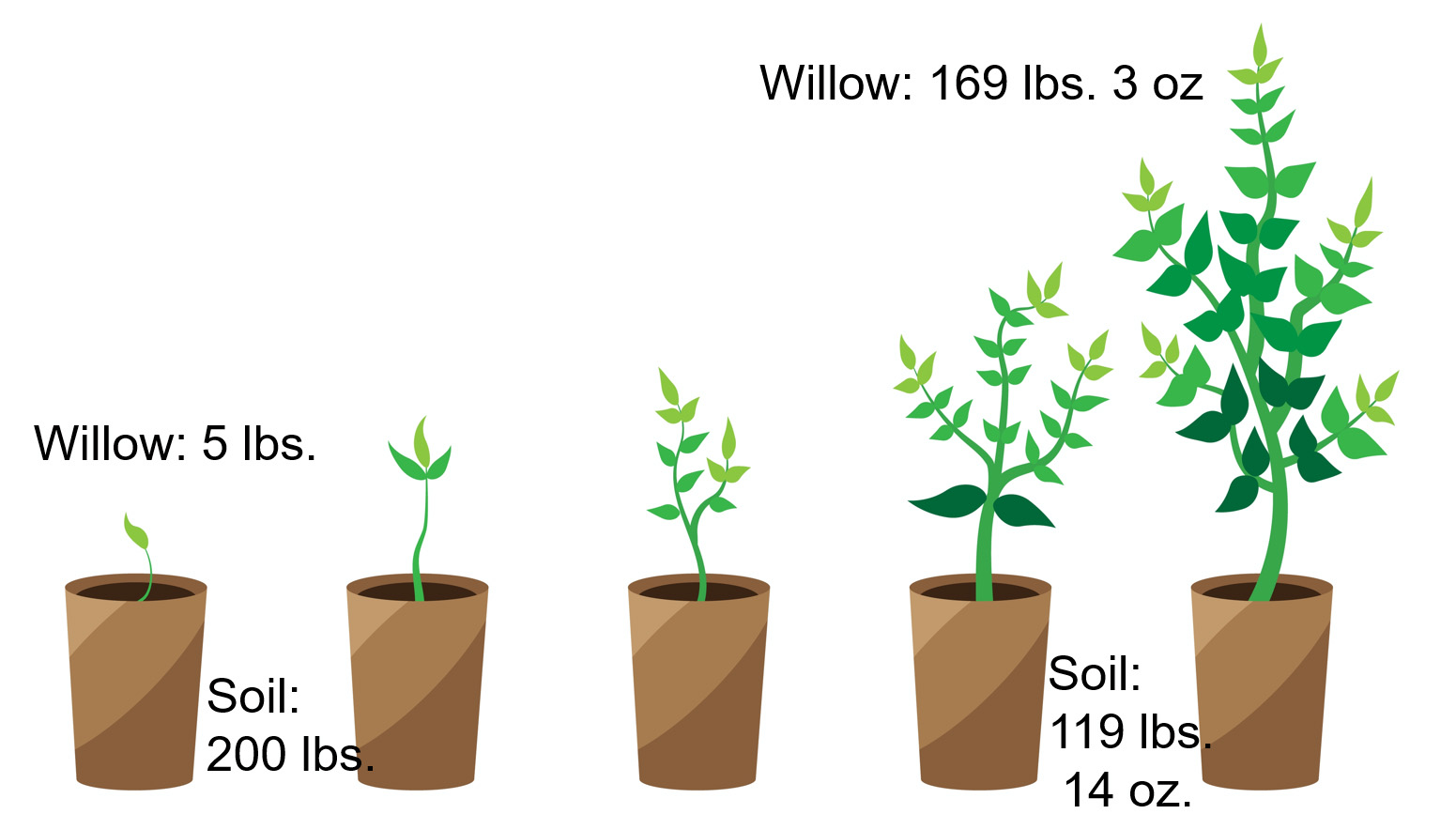
Where did that mass come from? Out of thin air? The answer of course, is, yes. It did. Most of the mass of the willow came straight from thin air. Through the miracle of photosynthesis, plants use light from the sun to combine carbon atoms from carbon dioxide. With this they make sugars, carbohydrates, and ultimately a variety of molecules.
Far earlier in Earth’s history, stromatolites, rounded boulders, composed of cyanobacterial layers, have been produced by the same miracle of photosynthesis. This is a photograph from Hamilton Pool, in Shark Bay, Western Australia.
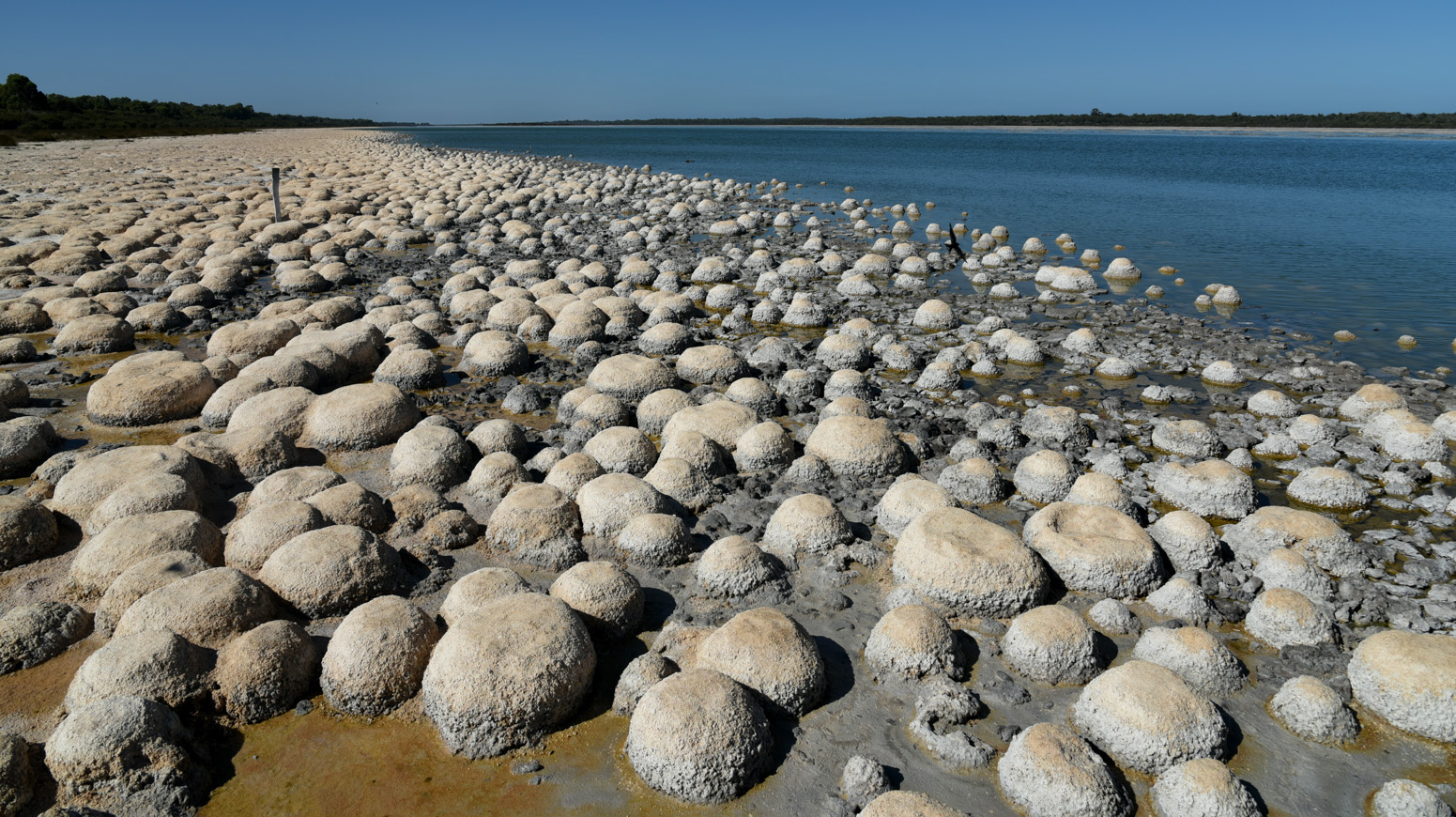
Cyanobacteria continued to bubble up oxygen as they split water into its components hydrogen and oxygen. They use the electrons captured from splitting water to power a chemical reaction that produces sugars and carbohydrates. So does every plant on the planet now.
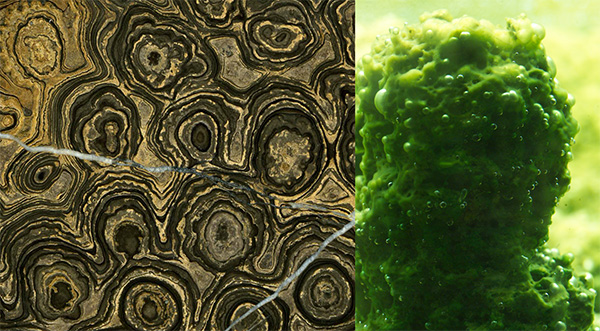
Cyanobacteria formed the earliest known fossils on planet Earth with some dating back to 3.3 billion years ago. Ancient stromatolites continually split oxygen and hydrogen, from water, day after day. Just like that stromatolite I photographed there at Shark Bay, you can see the little bubbles, bubbling up of oxygen everyday, everyday they bubble up. At nighttime they rest. During the daytime up comes the oxygen. This went on until 600 million years ago, when atmospheric oxygen reached 1% of current levels. That amount of oxygen screened out enough ultraviolet light that life could survive at the surface of the sea without having its DNA scrambled. There was a resultant of life explosion in the Cambrian period including photosynthetic life at the surface of the sea. In a relatively short additional 200 million years, oxygen increased to 10% of current atmospheric levels. That launched the Silurian period since enough oxygen was in the atmosphere to block UV light so that life could live on the surface of the land. As Nephi said, “thus we see by small means the Lord can bring about great things.” (1 Nephi 16:29). Now this vast period of time required to construct the oxygen atmosphere of the Earth approximately 2.9 billion years obviously does not correspond to the creation chronologies produced by ministers of religion in the 17th century. It would have been very difficult to generate the oxygen atmosphere of the Earth in seven 24-hour days or even in 7,000 years and without adequate oxygen produced by these cyanobacteria and other plants, animals and even Adam and Eve would have perished on this planet.

In 1654, Irish archbishop James Ussher published his deduction the Earth was created in seven 24-hour periods beginning on October 23rd 4004. He did this by you looking at the genealogies in the Bible --- so-and-so was the son of so-and-so -- and estimating about a 20-year generation together with Jewish chronologies determined that the earth was created on October 23 4004 BC. Not to be outdone, English churchman John Lightfoot specified that Earth was created on Wednesday, October 23 4004 BC at 9:20 AM.
One year when I was teaching undergraduate biology at Harvard on October 23. I mentioned this to Barbara who was always so wonderful, so she baked a big cake of the Earth showing the continents, with the motto that said “Happy Birthday Earth”.
So I carried this cake into my undergraduate biology class and we all sang happy birthday to the planet. We cut that cake at 9am on October 23rd. Unfortunately, it was not a Wednesday, it was a Monday, but you can’t have everything.
In fairness to Archbishop Ussher, I should indicate that a committee of our church in 1920 used his biblical chronology to put in dates in the Book of Mormon. These dates do not appear in the first edition of the Book of Mormon and presumably on the gold plates from which it was translated. Given the possible reference to the Holocene megafauna of North American in Ether 9:19, I wonder if the Jaredites dates might be slightly off --say by 10,000 years or so --but I digress.
The creation account in the Pearl of Great Price includes a key addition to the Genesis text. Each of the seven creative periods is there referred to as a time, which perhaps indicates each creative period be of indefinite duration.
The contrast between Ussher's fundamentalist dogma of the age of the Earth and the restored gospel was emphasized by the prophet Brigham Young who said,
“I am not astonished that infidelity prevails to a great extent among the inhabitants of the Earth, for the religious teachers of the people advance many ideas and notions for truth which are in opposition to and contradict facts demonstrated by science. You take for instance our geologists, and they tell us that this Earth has been in existence for thousands and millions of years… in these respects we differ from the Christian world for our religion will not clash with or contradict the facts of science in any
particular. You may take geology for instance, and it is a true science.”
In the Pearl of Great Price, we're told that God planted a garden and instructed Adam and Eve to care for it. A garden of course (and I was Director of the National Tropical Botanical Garden for seven years, so I know a little bit about this), is an artificial assemblage of plants that differs from the surrounding environment. It's designed for a specific purpose. Therefore, it's very dangerous to assume that the conditions inside the garden of Eden reflected what was going on outside the garden.
“And I the Lord God planted a garden eastward in Eden” ... Can I stop here at sort of a Rodney Dangerfield moment, because botanists don't get a lot of respect? Can I just say that to gardeners and botanists this account seems to be a truly divine calling. Let me just start again:
“I the Lord God planted” . . .in fact I mentioned that to a colleague, a physicist friend and he said actually botany is not the world's oldest profession at all, it's physics because God separated light from darkness. And then a friend who was a lawyer said “where do you think the chaos came from?”
Back to our text, “I the Lord God planted a garden eastward in Eden and there I put the man whom I had formed. And out of the ground made I the Lord God to grow every tree naturally, that is pleasant with the sight of man and man could behold it. And it became also a living soul.” (Moses 3:81-9)
Fascinating to me that the Lord here teaches us that the trees and by extension other plants are living souls and have spirits.
I’ve always had an unusual awareness of plants. My earliest memory as a child was seeing irises growing along the ditch bank, or the rough texture of juniper berries in my hand. I can't go into the dentist's office without seeing the house plants there. I notice plants wherever they occur. I delight in their presence.
When I was a little boy my mother showed me how to put dry beans in a mason jar, put a moist cloth in there, and press them up against the glass. In a few days the beans germinated, and little seedlings reached for the light.

Now I know more about the processes involved in germination than I did as a boy, but this simple experiment still enthralls me. Perhaps Alma had a similar thrill watching the germination of seeds, a process he compared to the development of our faith:
“And now, behold, because ye have tried the experiment and planted the seed, and it swelled and sprouteth, and beginneth to grow, ye must needs know the seed is good.” (Alma 32:33.)
As a botanist I’ve spent my life studying plants particularly in tropical areas. Much of my career has been spent studying plants as possible sources of new pharmaceuticals for our most serious maladies. About 50 percent of all the pharmaceutical compounds prescribed in this country are based on plants and other forms of biodiversity. I usually work alone and when I walk through the rainforest and I see the light filtering through the upper canopy of leaves, I feel as if I’m in a cathedral. I feel the spirit of the Lord and I’m overwhelmed by the beauty surrounding me.
I think Tennyson expressed a similar view in his poem “Flower in the Crannied Wall”:
“Flower in the crannied wall,
I pluck you out of the crannies
I hold you here, root and all, in my hand
Little flower—but if I could understand what you are, root and all, and all in all,
I should know what God and man is.”
(Alfred, Lord Tennyson)
Let's talk about the people. A major purpose to creation accounts is to emphasize the divine provenance of humankind. When Moses was tempted by Satan he responded, “Who art thou? For behold I am the son of God, in the similitude of the Only Begotten, and where is your glory, that I should worship thee?” (Moses 1:13)
So it is with all people. All of us who share this planet, all of us are sons and daughters of God. We're taught in the scriptures that human beings were placed on Earth at the end of creation, and on this point science and scripture agree: our advent on Earth is more recent than other species.

One consequence of our relatively recent origin is our extraordinary genetic relatedness. Unlike oak trees or squirrels, our species is genetically cut from the same cloth. Our genetic homogeneity is such that many scientists argue that the concept of biological races useful in categorizing wildflowers and wildlife should not be applied to human beings. We’re just too deeply related. Because of our shared ancestry, only a very few genes separate populations. That shared genetic basis of our species is so deep that if everybody perished except say the Tongans or the Hottentots we'd lose at a maximum, at a maximum, only two three to three percent of our genetic diversity. There are certain tribes in Africa such if they were the only ones spared some global calamity, we would lose virtually none of our genetic diversity as a species because we are so deeply related to each other. All the people who share this planet are indeed brothers and sisters and that is a scientific fact.
As an ethnobotanist I’ve studied with indigenous peoples ranging from the islands of the South Pacific and southeast Asia to the frozen tundra regions high above the Arctic Circle among the reindeer herders.

Although the languages and cultures and religions of these indigenous people are diverse, they all agree on one thing: the Earth is sacred. The sacredness of the Earth is also emphasized in the Pearl of Great Price:
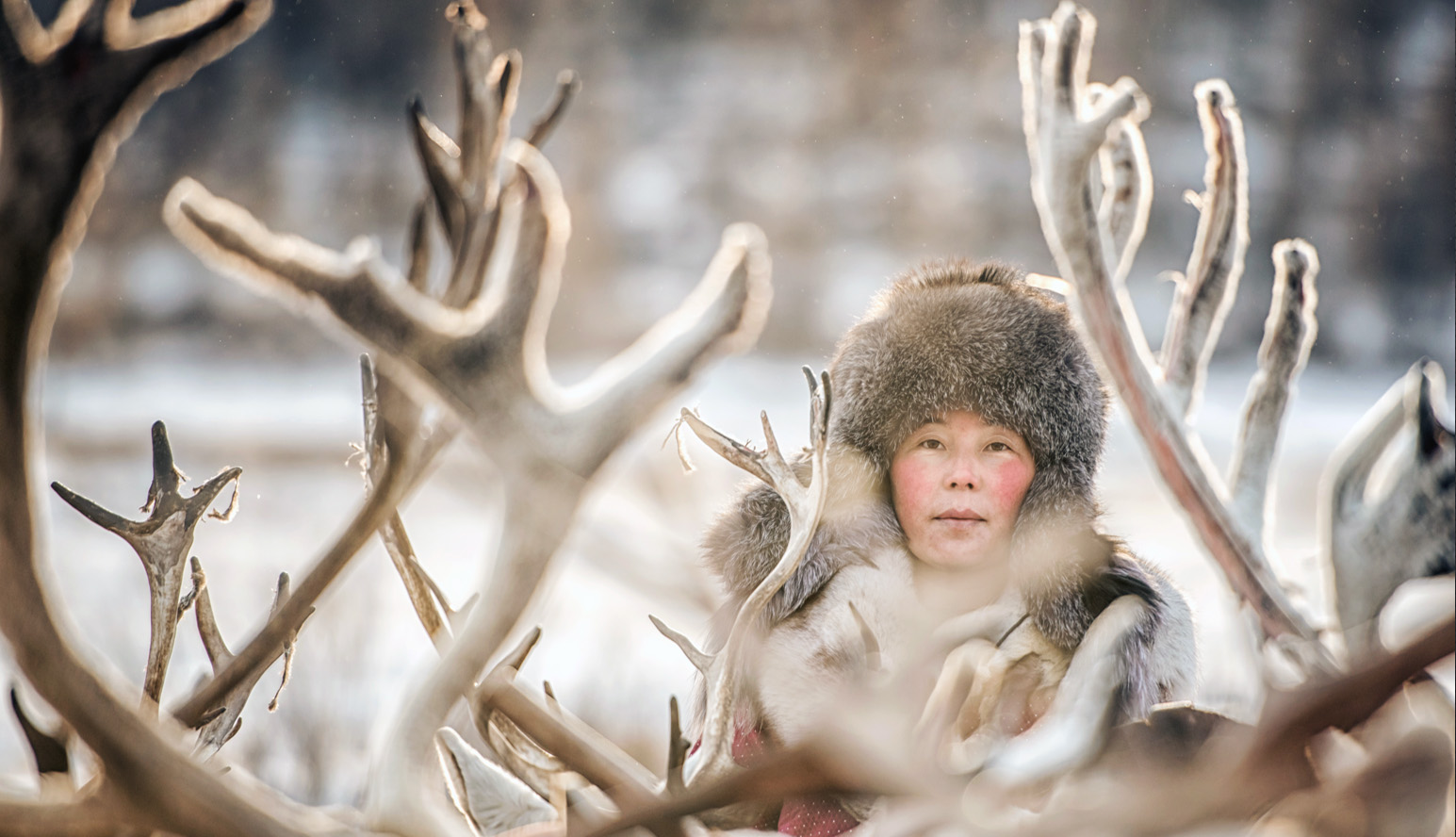
“And it came to pass that Enoch looked upon the earth and he heard a voice from the bowels thereof saying: wo, wo is me the mother of men; I am pained, I am weary because of the wickedness of my children. When shall I rest and be cleansed of the
filthiness which has gone forth out of me? Will my Creator sanctify me, that I may rest, and righteousness for a season abide upon my face?”
And when Enoch heard the earth mourn, he wept and he cried unto the Lord saying: O Lord, wilt thou not have compassion upon the earth? (Moses 7:48-49)
Many indigenous cultures believe this planet is animate, that it has a spirit, and that it is sacred. That's why so many of them pray before they'll even cut a tree down or begin a hunt. They promise to use nature's bounty with reverence. Indigenous people also believe that human beings are sacred and have spirits. It's very poignant to me that as early European explorers traveled the Pacific and traveled to North America and contacted indigenous peoples and asked them who they were a single universal answer emerged. The Navajos for example said we are the Dine. The Dine, of course, in Navajo means” the people”. The Polynesians said we are tanata or kanaka, which, of course, means “the people”. Now some early explorers mistook these terms as referring to tribal affiliations. Yet what the indigenous people were saying is we're people, we're just like you, we're people. Indigenous peoples, in my experience, believe that people are sacred and have spirits. In many indigenous cultures, such as the Maori, there's a belief that one's departed ancestors travel with you, that they're ever present. They're deeply aware of the progress of their descendants on Earth, therefore individuals are treated with respect not just because they are sacred, but they are surrounded with a cloud of witnesses from the spirit world.
Let me conclude on conservation as an act of worship. These three principles embedded within scriptural accounts of creation; namely the Earth is sacred, plants and animals are beloved by Heavenly Father, and human beings are of divine heritage, provide a strong gospel basis for conservation. As appropriate for the kingdom of heaven, which Jesus tells us is likened to a net that was cast into the sea and gathered of every kind (Matthew 13:47), it's understandable that reverence for the Earth will be expressed by different Latter-Day Saints in different ways. By considering the handiwork of God that surrounds us we can act as individuals, groups, communities and even nations to work together to protect creation. If done with reverence, it's my belief that these acts of protection can be transformed into worship. At a minimum, we need to avoid needlessly damaging the creation. If you love the Artist do not slash His painting. I’ll say that again, if you love the Artist do not slash His painting.
For example, we can reduce the waste we produce in our daily activities. What a thrill to have the BYU official here responsible for sustainability. We live in a day in which Moroni said there would be “great pollutions upon the face of the earth…when there be many who will say, do this, or do that, and it mattereth not, for the Lord will uphold such at the last day” (Mormon 8:31.) Contrary to what those people say we know that what we do does matter and that we can lessen our impact by reducing, reusing, recycling. A little secret: in our family is that we believe all life is sacred. This brings me into trouble, because I’m afraid of spiders, but my wonderful wife, who should have been an entomologist, carries them out alive at my request. I believe all life is sacred and the more I study it as a biologist, the more convinced I am the majesty of the creation.
Perhaps in coming years, all of us will know the number that refers to the tons of carbon dioxide that we personally produce as our carbon footprint, the same way many of us know our cholesterol number. One of the best ways to reduce our personal carbon footprint is to plant a tree. In this photo, in Tuvalu which is threatened with destruction by loss under the waves as the sea level rises, we funded these women to plant mangrove trees in return for building them a women's handicraft center.
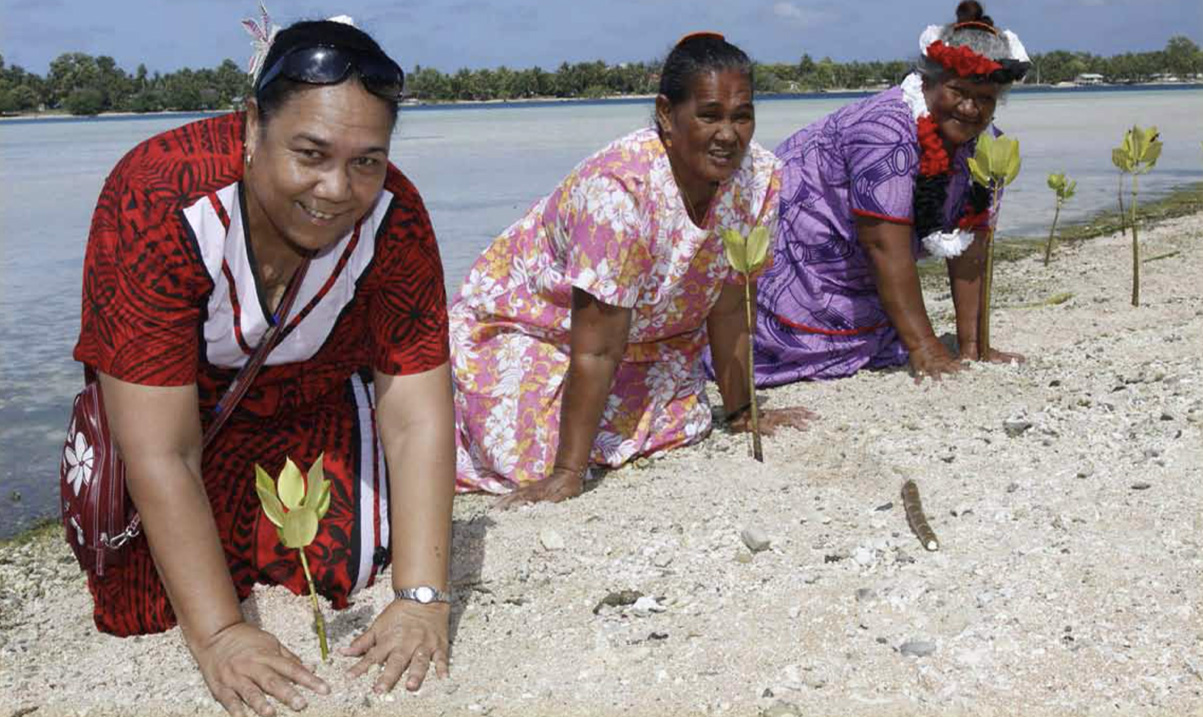
We know from van Helmont’s experiment that most of tree mass is actually sequestered carbon dioxide, so you can plant a tree and have a positive effect on the global carbon balance. We can also plant a garden. In the beginning Adam and Eve were asked to tend the garden. I don't think that dictate from Deity has ever been rescinded. Modern prophets have repeated requests from Brigham Young to “beautify your gardens, your houses, your farms; beautify the city. This will make us happy and produce plenty.” President Kimball talked a lot about this as did President Hinckley.
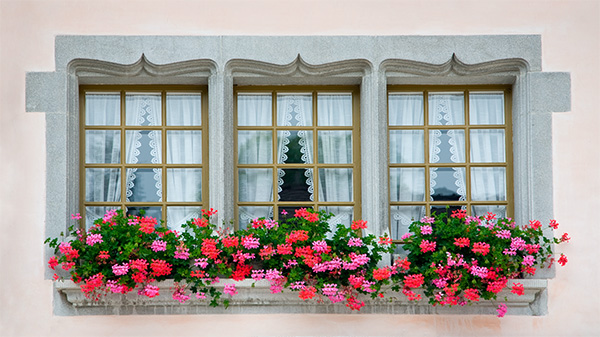
Even those who live in modest circumstances can plant a flowerpot in a windowsill. We can also treat our pets, livestock, and wild animals with kindness and care and dignity. We should receive all with gratitude for the bounty of the creation. The Lord said in the Doctrine and Covenants Section 89 that “all these are to be used with prudence and thanksgiving”. (DC 89:11). We can also help support local parks, national forests, and national parks. I don’t know if you know this but a freshman botany class I taught here at BYU came up with the original plans for Rock Canyon Park, designed the park, made a movie in which we had Hugh Nibley speak. That movie and the book they wrote was taken back to the Forest Service in Washington DC, taken to the city fathers, and led to the creation with many other good people of Rock Canyon Park. I had the great honor to help the village chiefs in Samoa and the Territorial government of American Samoa with the U. S. Congress to create the 50th national park of the United States.

This protects the largest acreage of tropical rainforests on US soil, spans three islands, and has some remarkable coral reefs.
It's a companion to a park that Barbara and I helped build in Western Samoa. Here we have a walkway tower that shows that the people could produce income without allowing the forest to be cut. People come from all over the world. That's my daughter Jane there walking across this walkway.
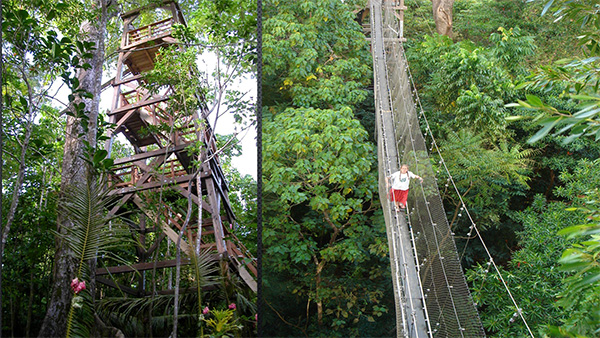
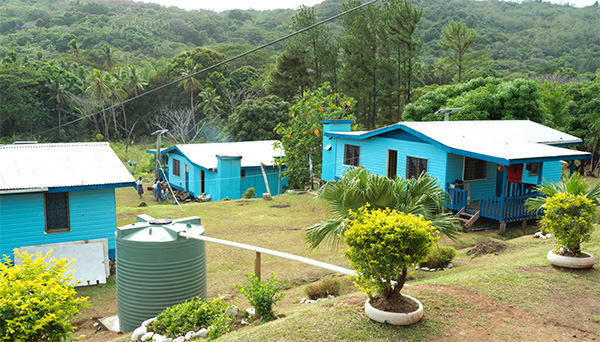
We can also join with other members and non-members in useful conservation initiatives.
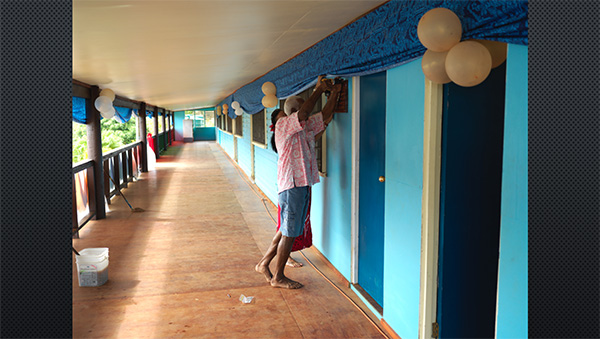
Barbara and I had the great pleasure of going to a remote island in Fiji to dedicate the first decent school this village ever had. In return the village agreed to protect their mangrove forest. This little girl on Barbara’s left came up and asked if she we could take her photograph. Some other children ran up. We found out this little girl walks every day eight miles to school just to get there and she's barefoot. This is what school means to the people.
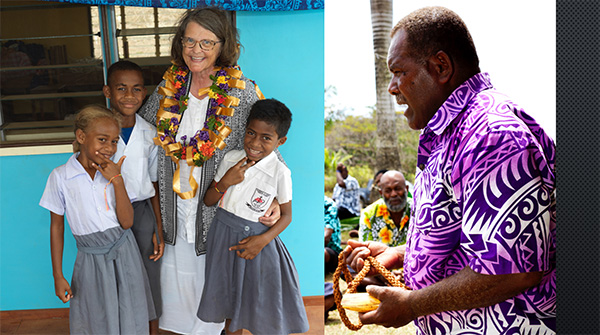
The chiefs responded to us by displaying a sperm whale tooth they have here and promising that they would protect that forest. Barbara and I together in Samoa with Ken Murdock, Rex Maughan, and other friends and family members created Seacology which is now headquartered in Berkeley. Seacology has built over 350 schools, medical clinics, water supplies, and sustainable electrification schemes in 65 different nations preserving over 1.5 million acres of rainforest reef. This place in the photograph in Madagascar was really touching. This is the southern part of the island, so helicopters can't get there. These people needed a school and promised that they would protect their forest and the lemurs that lived there. It turned out a river had to be crossed by children from another village to attend. It's seasonally high so we built a bridge for all the children to get from that village to this new school.

What I haven't told you is that this village is three days walk from the nearest road, so every board, nail, and piece of cement in that school was carried by the villagers on their backs for three days.
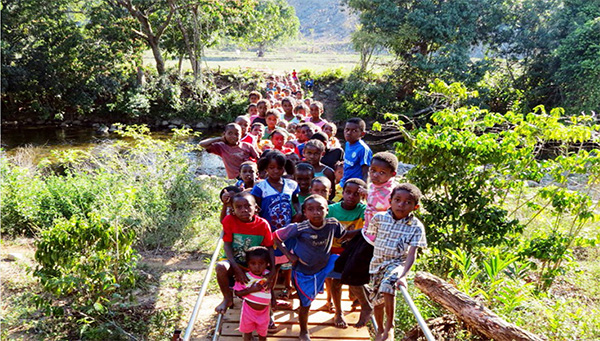
Today we have these little children getting into a decent school.
Coastal mangroves sequester more carbon dioxide than any terrestrial vegetation, so we recently partnered with the government of Sri Lanka who agreed to protect all the mangroves in the country in return for us providing micro-loans and basic business education for 12,000 impoverished coastal women.

As part of this we built a mangrove museum and three nurseries in different parts of Sri Lanka each producing 500,000 mangrove seedlings to be replanted.
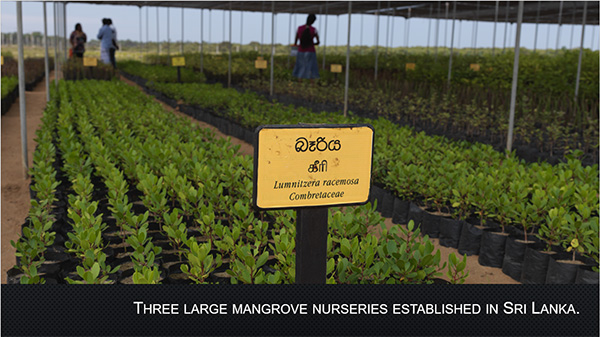
We met with the President and Parliament. They tasked their military to protect the mangroves. They took us out on a war boat; if you cut down a mangrove tree, you just might have a 105 millimeter shell coming your way. If you live through that, the coastal women are going to get you, so these are probably the best protected mangroves in the world. As a result, Sri Lanka was chosen to be head of the Commonwealth's carbon reduction program and we were nominated in Oslo for a special prize. In our experience indigenous people act as force multipliers. Through really precise injections of funds to build community projects, we're able to get some remarkable preserves for conservation.
In vision ---and let me conclude here -- Nephi saw that our members of the church would be “few” but also “be upon all the face of the earth”. We are citizens of over 160 countries. As members of the Lord's restored church, we speak 178 different languages. I believe even though we're few, we have a global platform that few other organizations have and then we have an opportunity to emerge as leaders in the international effort to protect the Earth.
We can, in our own lives, can be examples in reverencing the Creation. We can be exemplars of kindness and civility. We can seek to resolve our differences through discussion instead of violence and aggression.
War, in particular, has a terrible impact on the environment even though unfortunately it’s sometimes necessary to take up arms to protect our freedoms. But it's instructive for me to study the writings of the latter-day prophets who have consistently warned over nearly 70 years about the dangers of nuclear weapons which would have an overwhelming impact, negative impact, on the Creation if they’re ever used.
Ongoing environmental degradation and destruction of biodiversity has ominous consequences for poor people who do not have the material means to protect themselves against toxic waste, toxic air, water pollution, wildfire, increasing temperatures and rising sea levels. As Latter-Day Saints, I believe we should strive to exemplify compassion for others particularly for those who are impoverished. And as we seek to celebrate the Lord's Creation through our reverence for His handiwork we can build bridges with many other good people who do not share our faith.
I know that many scientists don't sense the touch of God in the beauty of a flower, or the majesty of stars at night, but I am unaware of any scientific experiment that proves that God does not exist or that He does not love us. As Alma said “I have all things as a testimony that these things are true” (Alma 30:41). I understand that many good people, some in our own community, believe that religious and scientific viewpoints cannot be reconciled. However instead of a conflict between science and religion, I perceive a vast, panorama that's been going on in this creation for nearly four billion years. We worship somebody who can foresee the loss of 116 pages of manuscript 2200 years in advance. I worship a Creator who could build an oxygen atmosphere for this planet over geological time. As Brigham Young said, and I’ll conclude on this, “Our religion is simply the truth. It is all said in this one expression—it embraces all truth wherever found in the works of God and all the works of God and man that are visible or invisible to mortal eyes.”
How wonderful to know that the Creator of such a vast and beautiful universe, at both the macro and the micro scales, is concerned with the details of our individual lives. I suggest that we can show our reverence and worship by caring for the details of His creation.
Fall Forum 2020: Discussing Sister Eubank's Three Questions
In November we held our annual Fall Forum virtually. We were thrilled to welcome back Sister Sharon Eubank, and fulfill her request for further conversation by hosting a panel to discuss her three questions from last year. Below, we include the video recording (also available on YouTube) and the transcript:
Natalie:
Good evening. My name is Natalie Gochnour. I’m delighted to welcome you here, virtually tonight, to the Thomas S. Monson Center on South Temple in Salt Lake City, Utah. We are here tonight for the LDS Earth Stewardship Fall Forum. It’s a time when we can take a break from the workaday world and really stop and reflect about the beauty and majesty of Mother Earth, and honor our Creator by examining the principles of earth stewardship. I’m really excited about tonight’s discussion.
We will hear first from Sister Sharon Eubank. Sharon is the first counselor in the general presidency of the Relief Society of the Church of Jesus Christ of Latter-day Saints. After Sister Eubank, we will hear from Sister Kira Smiley. Kira works professionally in ocean health and sustainability.
Sister Eubank, thanks for joining us tonight. I’m going to turn the time over to you.
Sharon:
I’m so glad to be with you tonight. When we met a year ago, we talked about what Zion has to do with stewardship of the Earth and you took the responsibility to think about some questions that were related to that, which I’m very grateful about. I asked three questions that all had to do with the building up of Zion and the vision of the last part of the Earth, as we believe as Latter-day Saints, and I know you’ve been thinking about that. I thought I would just frame those questions for you again and then I’ll talk a little bit about some of my own experiences this year that have got me thinking a little more deeply. I’m really looking forward to the panel as we discuss some of the things that you’ve thought about and some of the things that the panel will bring.
The first question was “When we waste what others desperately need, what are the ramifications to our physical hearts and our unity?” I had no idea when I asked that question that we would have a pandemic in 2020, and as a humanitarian I’ve been raised on those stories from the Great Depression in the 1930s when farmers could not afford to harvest their crops and so they let them just rot in the field. It’s the beginning of the Latter-day Saint welfare program because the stakes in Salt Lake City organized people to go down to Utah County and harvest the apples and the onions so that they could then keep them and they started a cannery and different things from that. I never expected in the year 2020 that I would see that same kind of situation, but the pandemic forced a lot of things on us that we had not seen in a very long time. I was as shocked as many other people to see pictures from around the country in the New York Times of dairy farmers who supplied milk to schools but nobody was meeting in schools and there was nowhere to sell it, there was nowhere to put it, so they were dumping it in fields for fertilizer. There were potato farmers and onion farmers who could not afford to harvest those because fast food restaurants weren’t serving potatoes and there was no place for the market to absorb them, and they were just rotting. There were really creative people—university students, communities, Latter-day Saint Charities was one of them—that thought, ‘This can’t be,’ and so they came up with creative solutions on things to do with that food so that it wouldn’t have to be wasted. You can see in this photo that one of the things Latter-day Saint Charities did was to go down to the dairy farmer exchange and buy the excess milk and then turn it into cheese. We used a producer up in Logan, Gossner Cheese, and they turned that excess milk into Swiss cheese, and then we turned around and put that into the trucks that went out to supply the food banks. Because at the same time that this food was being wasted, hunger was exploding in the United States and in many other places. We also dried that milk, we dried those potatoes, so that we could ship them to other places around the world. I’m really proud of the people who came up with creative solutions to that shocking waste, and I know that there are other wastes that we can think about with creative solutions that we can go forward [with] when we try. So that was something from my own experience for that first question.
The second question: “When we look at our own creations, or the creations that we’re a part of, how do we feel? How do we feel being in God’s and what is that experience like for us?” Probably like a lot of people in the middle of the pandemic, I was working from home and I felt a lot of anxiety. You’re reading scary news, there’s a lot of reports coming in from different places around the world. One of the things I started to do in April when it was one of the most anxious times was I went to a garden center along with my neighbor and we built garden boxes which we had never done before. I’ve lived in that house for thirteen years and never had any kind of a garden but this was the year. I have a black thumb; I have killed multiple plants and I’m very sorry about it. But I thought, ‘I’m going to try this year.’ So she and I hefted up these big 50-pound bags of dirt and I thought, ‘Well I’m going to plant strawberries.’ So I went to the local nursery, I got those strawberries, and you can see in these photos that I put them in. You have never seen a prouder mother than when that first strawberry blossom came! I was out staring at it in the middle of the night, looking at it during the day, and when the strawberries started to come I felt as if I had created the Earth in seven days. It was just so amazing. I mean you can tell because I’ve taken these photographs to show you. To see them start to get ripe and then to ripen. I have to tell you that I calculated the perfect moment to pick them so they would be at their ultimate ripeness and when I went out for my first five strawberries, the birds had gotten them that morning. I had missed them! So then I had to go get some kind of netting to put over them so that the birds and I could share. At the very end of this year, it became a sanctuary for me where that garden was. I actually wrote my conference talk that I gave in October out there in the middle of that. It became a place for me to feel how I relate to Creation, and also to feel the Creator in the smallest miracle of a ripening strawberry. When I think about how it felt for me to grow my own strawberries, and then to see the work and the effort that goes into just a basket of strawberries that are at the store, I would never ever be able to waste one of those again because of my experience this summer. So I feel the Creator in His creations in a very visceral way because of my own experience, and I hope you've had some experience this year as well.
The third question is a very relevant question to the 21st century where we live. I wanted to ask, “How can we frame the discussion so that we stop having the same unsuccessful conversation between people who believe in protecting the earth and people who believe in protecting business?” and that false narrative that goes back and forth. That's so unproductive and it's also false, and I am really looking forward to some of the comments that the panel will make about this. The question I asked was, “How can our hearts swell wide as eternity so that we stop having that unproductive conversation?” One of the things that I hope, and it's a challenge I'm throwing out to you, is we need to laugh more about earth stewardship. It is a serious subject, but we have sometimes approached it in such a way that it becomes so self-serious and I think there's real benefit—if we could get a stand up comedian to talk about earth stewardship I would love that because people need to respond in a different way. We cannot continue to approach it in the same way that we have. . . We want to appeal to new audiences. One of the things that happened to me this year was meeting Kira Smiley, who you're going to hear from later on in the program. She came to visit me in my office and when I heard about her, her studies, and the work that she's doing with ocean conservation, I recognized this is the future of this discussion. Kira is two generations away from me and she's a young person who has her credentials, who has her work experience, and is practically looking at real solutions. I'm very invested in what will happen for people who are in their teens or their 20s because this is really their conversation and we need to engage with them, but we can approach things in a different way and I think Kira will talk some about that.
I thought I would just close tonight with an encouragement. I had such a great experience with the scriptures and the hymns and the discussion that we had last year that I wanted to quote from Doctrine and Covenants 104. This is the doctrinal foundation that LDS Earth Stewardship is based on, and maybe it's something that I can leave all of us with before the panel begins. It says, in verses 13 through 18:
For it is expedient that I, the Lord, should make every man accountable, as a steward over earthly blessings, which I have made and prepared for my creatures. I, the Lord, stretched out the heavens, and built the earth, my very handiwork; and all things therein are mine. And it is my purpose to provide for my saints, for all things are mine. But it must needs be done in mine own away; and behold this is the way that I, the Lord, have decreed to provide for my saints, that the poor shall be exalted, in that the rich are made low. For the earth is full, and there is enough and to spare; yea, I prepared all things, and have given unto the children of men to be agents unto themselves. Therefore, if any [person] shall take of the abundance which I have made, and impart not his portion, according to the law of my gospel, unto the poor and the needy, he shall, with the wicked, lift up his eyes in hell, being in torment.
I don't always exactly know what to do, but I'm committed to change my actions to be more in line with this doctrine that I believe with all my heart, and I'm excited to be here with you today and for this great discussion. Thank you very much.
Natalie:
Thank you, Sister Eubank. I'd now like to introduce Kira Smiley. She joins us remotely from Europe. Kira is a program manager with a company that's called Tidal at Company X. Their mission is to improve ocean health and to feed humanity sustainably. Kira serves as her ward's environmental stewardship specialist and she has a BS and Master's degree from Stanford University. Kira, thank you for joining us tonight.
Kira:
Thank you so much for that introduction. I feel really privileged to have the opportunity to join Sister Eubank and all of you here today to share some remarks. Throughout my schooling and career thus far, I've had the opportunity to work on food systems and environmental challenges across the world. In my ward, as you mentioned, I’ve served as the ward environmental stewardship specialist for the past two years. Since my first Young Women's project, establishing a recycling program at our stake center, I've spent over a decade learning what it means to be a Latter-day Saint and an environmental steward. It wasn't until very recently that I actually learned about this organization but I'm thrilled to have discovered it.
Throughout my experiences working on environment and food systems [and] related challenges, two experiences have really stuck out to me in particular. Diving in the middle of the Atlantic Ocean during the 2019 Ocean Plastics Leadership Conference, everything was beautiful and blue around me until I started finding tiny bits of micro plastics: plastic jugs and plastic with marine animal bite marks and even a toilet seat. On a Romanian beach, we discovered a year's worth of plastic washed up on shore from across the globe, which solidified for me that the earth is part of an intricate and connected system, and everything we do has an impact. In southern Patagonia, I spoke with several fishermen who recounted how their fishing spots had dried up from overfishing and that they were running out of places to go next. This conversation reminded me of the Lord's teachings in Doctrine and Covenants 59. In order to have a continuous food source, natural resources must “be used with judgment, not to excess, neither by extortion.” I really believe that the Earth needs our wise stewardship today more than ever before. As members of the Church of Jesus Christ of Latter-day Saints, we learn through our doctrine that the Lord has commanded us to do so. Doctrine and Covenants 136 reads, “Thou shalt be diligent in preserving what thou hast, that thou mayest be a wise steward.” President Russell M. Nelson has taught (which Sister Eubank quoted last year) that, “As beneficiaries of the divine Creation, what shall we do? We should care for the earth, be wise stewards over it, and preserve it for future generations. And we are to love and care for one another.”
So what can we do to show gratitude and charity for the Earth and for each other? Personal conviction is the first step. Within the family unit, establishing love for the Earth and all of its creations early will help deepen that innate desire we have to care for the environment. Just as the sons of Helaman were taught on their mother's knees as children, so too was I taught at an early age about nature and the environment from my mother and grandmother, learning to love and respect the environment while growing up near the forests of Oregon and Finland. The LDSES website has an extensive list of actions for individuals and families to undertake, ranging from investing in more energy-efficient appliances, reducing water use and single-use plastics, using public transportation (when safe, now, and available), reducing paper use at church, and doing community environmental service projects, among many others. If you haven't yet, I highly encourage you to visit the webpage for more ideas.
However, I suspect that many of you are doing many of these things, and wonder what you can do to take your action to the next level and cause even broader change. One day-to-day choice that has a significant impact on our Earth is food. What and how you eat matters. In the U.S. alone, 40% of food produced goes to waste, which both causes greenhouse gas emissions [that are] 25 times stronger than carbon dioxide and contradicts what the Lord taught of using His resources.¹ Most of the food you buy often comes with plenty of plastic packaging, but taking steps to avoid this—whenever and however possible—and preventing food waste has enormous impact. This could include sharing extra food with neighbors in need or food banks, home composting food scraps, prepping your meals each week to avoid last-minute purchases that often have more plastic, choosing to not overbuy, taking a picture of your pantry and fridge before going shopping to recall what you already have, choosing to buy ugly or misshapen vegetables (which are often thrown out but taste just the same), and cooking in batches and freezing leftovers (which you have to remember to actually eat). There are so many different options, and you can get creative with it as well. In addition, we've all been in Sunday School lessons where this section has been glossed over, but the Word of Wisdom does teach us to eat meat sparingly. Designing your meals to be more plant-focused by eliminating or reducing meat from most meals, and moving it from a main course to an accent or garnish in several or all meals, has enormous implications across several different areas. The meat industry is, unfortunately, responsible for about 15% of global human-driven greenhouse gas emissions.² Mostly driven by beef, this uses significant land, water, and energy, and causes runoff into rivers that cause harm to aquatic life downstream. But even more so, to satisfy this growing global demand for meat in excess, cattle ranching has become the largest driver of deforestation in every Amazon country, which has major implications on the biodiversity there and can even impact weather patterns.³
I know that changing your lifestyle to adopt new food, energy, and transportation habits may seem really challenging, but just as when we choose to follow certain standards of dress and language, committing once to follow these principles will make it so much easier than having to make that same choice day after day. I led a class at a local college where we help students to redesign their lifestyles to be more sustainable. One activity that I taught was to storyboard out your day with all of your new choices, while still meeting key needs such as health, warmth, and safety—and then to test it out. If you slip up, it's important not to give up! Changing your lifestyle is all about iteration and designing ways to make it easier to make the choices you want to make. If something doesn't work, try something else. Similar to exercise, you need to find ways to integrate new habits in a way that works for you, or you won't do it. Our actions over time will have a major impact, but you can exponentially increase the ripple effect of your actions by setting an example and encouraging your friends and your neighbors, with love, to do the same. While many of the actions associated with environmental stewardship and sustainability have been incorrectly and tragically politicized, if each of us can successfully share the connection between environmental stewardship action and their root gospel principles, we will have so much more success in helping to transform our communities and our world. The Prophet Joseph Smith stated that he taught correct principles and the saints govern themselves accordingly. Please note that in addition to having the knowledge of these principles, the saints also had the motivation and the desire to keep them, because they recognized their source as being the Lord and trusted that acting on these principles would ultimately be for their own benefit and that of Zion.
I mentioned my Young Woman medallion project at the beginning of my remarks. Ultimately, this effort unfortunately failed. While I and another young woman set up the bins, posted signs and instructions, and spent many weekends emptying the recycling, we did not sufficiently teach our ward and stake of the gospel principles connected with this new system. In doing so, we lost an opportunity to help instill that internal motivation to act. To encourage future generations to protect our planet, we can also choose to actively involve children and youth in environmental stewardship activities. As the ward environmental stewardship specialist in my ward, I've organized a native shrubbery activity, planting these with a local environmental nonprofit. I've worked with the activities committee to set up and design zero-waste potluck events, worked with members to establish recycling and composting within the ward, and led firesides teaching how environmental stewardship is related to gospel principles. These are just a few ideas of what you can do to help engage your ward community as well as your neighborhood. Remember that teaching the why behind the gospel principles of earth stewardship is equally if not more important than teaching the what, in order to promote longevity and action and prevent positive changes from disappearing as soon as we stop actively managing them. As Elder Boyd K. Packer taught, “True doctrine, understood, changes attitudes and behavior.”
Finally, remember that your environmental stewardship and daily choices have ripple effects across the planet so you must think holistically with what is referred to as a systems mindset. The majority of those who suffer from the impacts of intensifying and destructive weather phenomena, occurring more and more frequently, are often composed of the very families who live in regions of the world lacking the resources and physical and economic buffers to cope with many of these impacts the same way you or I might. Many of our brothers and sisters in the gospel live in many of these areas. Without feeling the effects so strongly, it's easy to avoid feeling a strong connection to these impacts or to fail to take action to mitigate them. But we can choose to donate to established, trustworthy organizations working on the issues, and when we think at a systems level and exercise charity, we're more likely to choose to be wise stewards of our environment, our energy use, our waste practices, our transportation and eating habits—because we understand that they have worldwide implications.
I am deeply moved, whenever I reflect on the deep trust our Heavenly Father has bestowed upon us as stewards of His magnificent creations. Being a good steward shows gratitude for everything we have and will unlock blessings for you, your community, and the people worldwide for generations to come. Each of us is a lever for change, and I believe strongly that we have the power to set a good example and to guide others to gain that same desire to take steps to be effective stewards of our planet.
Thank you again so much for the invitation to join you today and for the opportunity to share some thoughts. I encourage you to reach out if you have any questions or thoughts. I say these things in the name of Jesus Christ. Amen.
Natalie:
Thank you, Kira. It's now time for what I'm going to call a fireside chat. In addition to Sister Eubank and Kira, I'm going to bring two others into the conversation. Happy to welcome Shannon Ellsworth. Shannon is a member of the Provo City Council and she's Vice Chair of the board with LDS Earth Stewardship. Welcome Shannon. I’d also like to welcome Chip Oscarson. Chip teaches literature and film at Brigham Young University, and directs BYU’s Scandinavian program. Welcome Chip.
We are here tonight at the Thomas S. Monson Center in Salt Lake City on South Temple Street, but in 2019 LDS Earth Stewardship was at the White Chapel on Utah's Capitol Hill. Sister Eubank addressed us there and left us with three questions and invited us to engage with her. So tonight, during this fireside chat, we're going to unpack these questions and talk about what we learn as fellow panelists but also some of the comments that came in from other people who listened to the speech, who had comments about it, and have engaged with us. So I'm going to just read these questions out loud and then I'm going to turn to some of the panelists and reflect upon what was submitted to LDS Earth Stewardship and see what we learn from that. So here's the questions:
- When we waste what others desperately need, what physically happens to unity and our hearts?
- Why do we feel God in His creations? And what do others feel in our creations?
- What would move our hearts to swell as wide as eternity?
Some pretty profound questions. On question number one—when we waste what others desperately need, what physically happens to unity and our hearts—a gentleman named Ralf has submitted this comment: he said, “When we waste resources others need, we hurt the overall community and diminish our own spirituality.” Chip I'm going to turn to you first. Do you feel like we diminish our own spirituality when we waste what others need?
Chip:
I think so. I think that it's a really important point, what's motivating this question, this idea: that we're connected. Our spirituality is connected to other people around us, and we can't expect that we can act in a way that doesn't have repercussions for people around us. I think that when we understand the way that we're connected, when we understand the way that our actions can positively or negatively impact others that we don't know or that we don't see, that aren't in our immediate vicinity, that that leads us to act in a different kind of way. If the two great commandments are love of God and love of our neighbor, these really come together in terms of how we use the physical creation that God has given us. It's a manifestation of His love and how we use it, the way that we use it, has implications for our attitudes towards other people.
Natalie:
Kira, as I listened to your remarks I felt like there was a lot of spirituality implicit in what you were sharing. Would you like to comment on what Ralf said: basically that when we waste resources others need, we not only hurt the community but we hurt our own spirituality?
Kira:
Absolutely. That hits me deeply; I think it was really profound. I think it goes back to what I mentioned from Doctrine and Covenants 59, which does teach that we need to not use things in excess or by extortion and in doing so, we're not just doing something that is sustainable (although it is), we're really hailing back to the core principles of charity, because we're thinking of our fellow humans, we're thinking of our brothers and sisters, and we're considering them and their needs so as to not take more than is needed to ensure that we can all participate and all benefit as much as we can equally from the resources that we have available on our planet.
Natalie:
Sister Eubank, you started all this so I'm going to come to you, but first Shannon—do you want to add? This is an opening question about how when we waste resources it impairs our spirituality.
Shannon:
Yeah, I appreciate that sentiment. I think it's very true. In 2020 we can see now better than ever how something in our community, in our country, or in our world can affect people on the other side of the world. Certainly our health is connected to people around us and our social and environmental health affects people around us, as does our spirituality, as does the way that we use and conserve or utilize resources.
Natalie:
Sister Eubank, do you want to comment on this?
Sister Eubank:
Yes, since it's my question I would love to! I really appreciate what Ralf said and then the comments that have been made.
The Lord gave us two gifts. The first one was agency, which Chip referred to, and then the second thing is we are all connected to each other; we cannot survive spiritually or physically if we aren't. It's part of the same system, and we have to learn to use our agency to choose to say to other people, “Your success is as important as my own success.” When we waste something that somebody else desperately needs, it's as if we are saying to them, “I care nothing about you. I don't care at all about you because the system that combines us, I'm breaking it. I’m cutting that string that connects you and me.” So in order for us to keep those two great commandments that Chip talked about—to love God and to love each other—we cannot waste what other people need. Now in a modern life it's really hard not to waste things. We are set up for this disposable society, and Kira talked a lot about that, but the ways that we can minimize waste so that other people might thrive, I think, is the measure of our humanity.
Natalie:
Thank you. I love that Sister Eubank asked us to engage and to be a part of this conversation.
Becky wrote in, “Disparity makes the experiences of God's children poignantly different from each other. At the same time that that's our reality, we also know we're commanded to be as one. If our use of resources is impeding our ability to see others as brothers and sisters, as equal heirs to the kingdom of God, then I think we're using them wrong.” And then she writes, “We can move towards greater unity by thinking outside ourselves, letting our heart lead us to be careful consumers.” So Shannon, careful consuming will help us be more unified; do you buy that?
Shannon:
Yeah. This makes me think of this concept of everything that our Heavenly Parents gave us, they gave us so much and all they really ask in return is a little bit. And our parents here on Earth have given us so much, and all they really ask for in return is a little bit. And this maternal planet that we live on gives us so much, and in return we just need to give a little bit. So I think that ties into this idea of being a careful consumer or, as Elder Maxwell used to say, a “consistent environmentalist” in returning a little bit or being conscientious in how we use these resources.
Natalie:
Shannon, did I hear you right? You said maternal planet?
Shannon:
Yes.
Natalie:
I like that and I noticed Sister Eubank smiled as you said it. Sister Eubank, what does that mean to you when you hear “maternal planet”?
Sister Eubank:
Well, you know, I automatically think about Moses 7 where Enoch sees the Earth and that she cries and groans because of the pollutions that are upon her. I think that’s specifically for our day; it's more true in our day than any other day.
In my earlier remarks I referred to the food waste that's happening in the pandemic and how shocking it was to see milk that was being dumped in fields—that we haven't seen since the Great Depression—because we didn't have use for that milk because schools were closed and there was nothing else people thought to do except to just dump it into fields as fertilizer. But what I love are the people who said—they didn't say, “There's nothing I could do about that.” There were creative university students, there were people who worked at Latter-day Saint Charities and other places, who said, “We have to do something about that. We can't stand by and watch that kind of large-scale waste.” And then they found something to do about it and so I was really happy to report about that. I love that spirit of not standing back and saying, “There's nothing I can do about that,” but recognizing, “I can find something to do about that.”
Natalie:
Chip you have four women talking about being careful consumers and how it unifies us. We're talking about maternal planet Earth. We need your perspective here.
Chip:
Well I agree with what's been articulated. I think that one thing that maybe folds into this a little bit is that we get, sometimes, too caught up in our idea of ownership, and this is what I think several people are getting at. If we remember that everything we have is a gift to us, that we think about it in terms of gift, that invites a different kind of gratitude and a different kind of understanding of our responsibility of what to do with the things that we've been given. If they don't belong to me, in the way that sometimes we talk about belonging, that they're gifts to be returned. I'm more careful with a gift: when I think of something as a gift. I’m more likely to value it, to cherish it, to take care of it, not to use it to excess. I think that part of the problem is that there's a lot in our modern society that invites us to think that we deserve it, that we own it, and those kinds of attitudes I think can be really damaging, both in terms of how we treat what we have been given but also how we make these gifts available to others. This is the idea of stewardship: I don't own it, I'm taking care of it; it's on loan, in a way, or it's a gift. I like the idea of a gift.
Natalie:
Chip, let's stay with you for a minute. I've got another comment that came in to LDS Earth Stewardship. This is from Tēvita. Tēvita writes, “The second great commandment, after loving God, is to love your neighbor. I see two important interpretations of who our neighbor is. I've come to see ‘neighbor’ . . . as also including animals and plants. They're also your neighbor, and you should take care of them and love them.” So Chip, I'd love to hear you expound upon that as someone who's an expert on these types of topics.
Chip:
Yeah, I think that's a really great comment to think about how we exist in both human communities as well as ecological communities. Just like we are responsible and have agency within our human communities and can build those and we can make them stronger, more vibrant, more resilient, so too we can do this with our ecological communities.
We have very interesting and unique doctrine regarding how we see the rest of Creation, that we believe that everything has spirit, and we can't undervalue what the implications of that [are]. All these things around us have their own purpose in Creation and that's to be respected. Part of our stewardship and our responsibility is to help these other things that are different than us to live up to the measure of their creation. Our ability to feel charity for something that's different than us, this starts in understanding the way that people are different and being able to show charity towards other people. But so too having charity towards things that are radically different than us, that have more legs or eyes than us, that don't have legs, that grow in the ground—this is a test of our ability to love and to show love, to show forbearance, to show patience and kindness and mercy.
Natalie:
I knew, Chip, you were the right person to start with on that. That was wonderful, and the notion that everything has spirit and everything has purpose. Rather than direct a response to that, who wants to jump in there? Because Chip gave us a lot to think about. It looks like Kira; go ahead Kira.
Kira:
Yes, it reminds me of the teaching that we have from the scriptures of “love thy neighbor as thyself.” I think that, just as Chip said and as the comment said, when we're thinking in that holistic perspective and that systems mindset, we can love equally beyond just our neighbor next door but realizing that every action we have is connected across the planet and has implications across the planet. . . We're an action-driven faith and so when we take action and we want to show love, the two are connected and we can't pontificate on these things and talk about earth stewardship without then really expressing our love through actions and through the way that we behave. That can be increased by magnitudes when we understand that each creation, every living thing, does have a spirit and has a right to grow and thrive, just as much as we do.
Natalie:
Shannon, so Tēvita says that animals and plants are our neighbors. I'd love to hear you comment.
Shannon:
Yeah, I think that's a beautiful concept. I have spent many of my teenage years on the family farm and every day was interacting with horses and cows and chickens. For me it was a truly impactful experience to see a horse be born and then have a personality, have needs, have good days and bad days, and then eventually die, which was, for me, an extremely impactful experience, a very powerful and spiritual experience to see that something God created has life in one moment and doesn't have life in the next moment. It's very powerful and it's a testimony of life and the sanctity of life. I just really appreciate the lessons in life that God has given me through the animal kingdom: some of those are in the Old Testament, some are in the New Testament, some are about pioneers and their experiences with animals. To me, the animal kingdom, part of the fulfillment of the measure of their creation is to teach me something. I'm grateful to God for that.
Natalie:
Very nice. Well, I'm going to go on to question number two.
Sister Eubank:
Before you go on, can I just comment?
Natalie:
You sure may! Please.
Sister Eubank:
As I listened to Shannon's comment I think about [how] plants and animals in the animal kingdom, they have a voice but it's a very subtle voice and it's very difficult for them to compete with us when we're at the top of our voice. But for temple-going people the way we are, when we attend the temple and we go through that Creation experience that we go through every single time, that is when they get their day and the Lord gives them their due in those days so that we, sitting in that audience, participating in that temple ceremony, would revel in who they are and their part in the interconnectedness with us. For me that's part of the joy and the beauty of being a temple-going woman.
Natalie:
Thank you, Sister Eubank. Alright question number two, here's what it is: why do we feel God in His creations? And what do others feel in our own creations? So this is really a creation question and a woman named Jenn Lee writes, “Primary songs such as My Heavenly Father Loves Me teach an answer to this question. Whenever we pay attention to the living things around us and simply step into nature and take heed, we cannot help but feel divine energy.” I thought that was a pretty insightful way to capture this: this divine energy that we get from our Heavenly Father's creations. Shannon, let's go to you first. Do you feel a divine energy when you're in nature?
Shannon:
I do. That's where my testimony has grown and has been nurtured. It’s where I have an ability to commune with God seemingly without ‘cloud cover.’ There's just a more direct line, a less polluted line, to God. I think part of that comes from what we learn in the Book of Mormon where God's creations are truly a testament to Jesus Christ. As a people, we value those testimonies of Jesus Christ. We value the missionaries and the missionary program because of the testimonies that they bring to our lives. We value the Book of Mormon because of the testament that it is in our lives. And we value these natural spaces and these opportunities to be outdoors and see these small, tiny, miniscule, microscopic testimonies of Jesus Christ as well as these landscape-scale testimonies of Jesus Christ. Certainly there's a unique connection with God when we’re in nature.
Natalie:
Chip, as someone who teaches literature and I would guess a lot of environmental literature, do you see this in your students, that when they read and confront nature that they capture or feel that divine energy?
Chip:
Oh absolutely. When I teach literature about the environment, one of the important things I like to do is to invite my students to go outside and to experience it, to underscore to them as well that the experience of God's creations (I teach at BYU so I can put it in those terms)... You don't have to be in a national park. You don't have to find some secluded place without people because people are nature too. . . I love the way it's articulated in the book of Moses, in the third chapter where everything is created spiritually and God is explaining this in this vision to Moses. He's talking specifically about trees and the way that trees are introduced is that they're created first spiritually before they're created physically, and as they're created, I think three different times in this verse (verse nine), He talks about their aesthetic qualities (that you could behold them and they were good and they were right) three different times and then finally says, “Oh, and they're useful too, for food and other things.” These things are also meant to be used, but if we remember these aesthetic qualities that you're alluding to, it invites us to have a different kind of relationship to them. They're not an inert resource to be used up, but something for us to be in a relationship with. That relationship tests our love and our capacity to to relate to other things—which is a divine attribute, right? To relate to things that are different than ourselves. And we need to be inspired by these things, by both the beauty of creation as well as the art that helps us to see it in new and different kinds of ways.
Natalie:
Kira, I'm going to come to you with this next comment. A gentleman named Phill wrote in about the notion of sauntering instead of taking a hike, and he quotes John Muir. So let me read this: Phil says, “I believe that when people sincerely seek a connection . . . in nature, it's impossible not to feel something. Rather than passing through nature on our way to a destination, searching for holiness along the way will help us recognize God's presence.”
Kira:
You know, that’s so funny because when the previous people were speaking, John Muir actually came to mind, so it’s great to have Phill bring that up as well. Absolutely! I think my nature is to try and go as fast as I can to the next thing and to the end, but over time I've learned so much about being able to take in those tiny details and appreciate the journey. I think that in doing so, I’ve gained such an appreciation for the beauty in all the nature that surrounds us, and to be able to notice when there are slight changes. I think that when we saunter, then we're actually better able to notice how we're having an impact and notice those nuanced changes which helps us key in to the system, and how the Earth is a system, so that we can better think about our influence and think about how to mitigate any kind of damage that we might cause to the environment and to our planet. Really keying in and sauntering, like Phill said, allows us to get the detail that helps us see those connections, and that will help us to better appreciate and act with that systems mindset.
Natalie:
Thank you for sharing that. Anyone else in our fireside chat here want to talk about sauntering?
Sister Eubank:
I'll talk about sauntering all day long!
Natalie:
Let's do it Sister Eubank.
Sister Eubank:
I had a friend who contracted pancreatic cancer and so I said, “Let me come down and visit you.” So I drove to where he lived, and he was a type A personality, we’ve worked together and you know like Kira said there's just [claps hands together a few times] I've got lists and I've gotta have things done. I walked in his house and he said, “What do you know about multiply and replenish the earth?” And I'm like, “Hi Lloyd.” The last thing he wanted to tell me, he said, “We think this is about having children and it is, but it's about this great commandment to multiply and then allow Creation to give us energy back. If we just multiply, multiply, multiply, and we don't replenish,” he said, “we hurt ourselves, and we don't accept the gift that God gave us.” So sauntering is not about multiplying, it's the other stage about replenishing. For someone like me who has a lot of energy and feels like I have a lot of things to do, that aspect has changed my life and I'm really grateful for it.
Natalie:
Really beautiful. Chip, how about your comments on sauntering?
Chip:
Yeah, both these comments and the original question itself leads me to think about the idea of creating. When we're sauntering we're not so driven on goal that there's this exploration that becomes possible. I think that the agency that we're given allows [and] invites us to be creative. And to be in creation inspires creation. There's so much in our world today that invites us to be consumers: to not focus on how we are productive and how we contribute in different sorts of ways but puts us in a passive position. Something as simple as President Kimball's admonishment to plant a garden, that what happens when you take on that role of helping creation: it connects you with different cycles and different beings and different things; you have to think in terms of different rhythms than maybe you do in your typical work. Even if that is, you know, a small spot on a balcony, where you can have a tomato plant or some herbs, there's still something I think that that connects us and reminds us of something that takes us out of this trap where we are simply consumers that are being directed by whatever forces that surround us but that we take back our own agency in something that can can be incredibly constructive for the things and the people around us.
Sister Eubank:
I certainly felt that with strawberries.
Chip:
It's a give and take with strawberries: that you can't force them to do anything, that you have to be patient and wait for them. Give them what they need and then they give you something that... I mean, where does a strawberry come from? It's carbon and water and sunlight—and it's a miracle every time you get a strawberry.
Natalie:
So Phill asked about sauntering. Jenn Lee asked about divine energy. I’ve got one more on this question I want to bring up, and this one deals with spiritual DNA or a spiritual signature as it relates to nature. This is from Becky and she writes, “Everything you create leaves a piece of you . . . so when we are in God's creations, we are witnessing his spiritual DNA. His signature is there on everything: on every mountain, every hillside, every cloud, every star, every sunset. As we spend time in nature and intentionally seek to recognize that spiritual signature, we can become more adept at witnessing the Creator. As we see it over and over, our eye [is] attuned to that more carefully, like an art historian or a food critic.” Really nicely said. Sister Eubank I don't usually want to go first to you but I'll bet you love that response.
Sister Eubank:
I really love that response. It's significant to me that the one of the names of Jesus Christ is Emmanuel, which means “God with us.” So I really resonate to that idea that His DNA, His expressive essence, is in everything that He has created so that He is with us as we experience the world that He made for us. That really resonates with me.
Natalie:
I invite the others to comment on this spiritual signature that's in everything that we experience in Mother Nature. Chip, let's go to you first.
Chip:
Well, I think that one of the things that this reminds us[of] again is our kinship both with God and with the things around us, that we're made of the same stuff, so to speak. Remembering this kinship both motivates my actions, you know, realizing my responsibilities to my co-creations, the things that I inhabit Creation with, but my responsibility to my Creator. And I really like the idea that we are fundamentally linked in these different sorts of ways.
I think that too often there's been a false choice presented to us that we can either choose the environment [and] other creatures or we can choose people, and something that I really appreciate about what Sister Eubank has invited us to consider is that it is a false choice right, and that so often taking care of our fellow beings involves... Well, you don't choose one over the other and healthy environments usually lead to healthier people, and that this is a way to show this love.
Natalie:
Yeah, interesting. Shannon, love to hear your thoughts.
Shannon:
When I think about a signature on a painting, it's a reflection of who created that. We know who created this world, we know who created our bodies (one of the highest creations), and if we put down or we think less of or we have some negative opinion about God's creations it is, in fact, Him and His son and really these eternal beings that... it's these eternal beings that we are minimizing or not expressing gratitude for, turning our backs on. I love what Paul Cox said: “If we love the painter, don't slash the painting.” And indeed we are a part of that painting and our bodies are something that we should not put down, that we should not commiserate over. We are made in the image of divine gods.
Natalie:
Kira, we’ll let you finish this one off. And again, this notion that the Creator leaves his DNA on everything and so when we are in nature, we're getting a piece of that spiritual signature.
Kira:
Thank you. I recall, a few years back when I was working on environment energy issues in Japan, I remember summiting Mount Fuji at about 4 am with people from all across the world from all different nations and seeing the sunrise together. I remember distinctly feeling as I looked around and sort of shared the view with everyone that God is here. I think that's so true when we are in nature but also our environment is where we work, we eat, and we play, and so even outside your front door or through the window or, as you mentioned, a strawberry plant. The spiritual DNA I think is so present and once we start recognizing it, you can't stop seeing it everywhere. It is everywhere and I think that just as there's a spiritual DNA that God leaves on every creation, we also similarly as humans with a capacity and with agency and a capacity to create, we also leave our footprint or our fingerprint on our world. This geologic age has been referred to as the Anthropocene, which is this period during which human activity has been this dominant influence on the climate and the environment: a whole different geologic era! I think that speaks large amounts to how much influence we have on our planet. So we want to think, in addition to recognizing the spiritual DNA and the footprints and fingerprints across the world and Creation, we want to think about what our legacy and what our fingerprints and imprints on our planet will be too. If we think about that, I think that we’ll be so much more conscientious and willing to take the actions necessary to create things that are beautiful and preserve things that are beautiful.
Natalie:
Thank you, Kira. Okay, we're gonna move to question number three, and the way Sister Eubank phrased this is she said, “What would move our hearts to swell as wide as eternity?” One of the comments came from David, it was very simple. David writes, “Surrender to God fully and receive Godly love.” It's a beautiful way to phrase it. We’ve heard of godly sorrow. What do you think of, Chip, when you think of godly love?
Chip:
It makes me think of the way that I understand and I feel love is first and foremost in my relationships with other people here on earth, right? So I think about the fact that our Heavenly Father has chosen that particular title; it makes me think of my earthly father and my earthly mother, and the way that they showed love to me: that love is something that is offered up without any expectation of a return. I'm lucky enough to have those relationships that I can draw strength from and I know that not everyone is able to benefit from those kinds of loving relationships with parents that can set this kind of example, but it's not hard for me to be able to understand, then, the kinds of gifts that I experience that are part of this Creation as coming from loving Heavenly Parents, a loving Heavenly Father, that would understand my needs and gives so much to me freely. I think that this comment that David's made is really insightful: you have to open yourself up to it. You don't have to view the world that way, and in a lot of ways it's a choice. It's a choice to open ourselves up to let that love flood in. In the same way that two people can look at the same view over a beautiful valley and one can see the beauty and grandeur of God's Creation and the other can see real estate waiting to be developed or resources waiting to be exploited in one way or the other—this is a choice and we have more agency over how we see these things, I think, than we realize. So it involves opening ourselves up to God's love to be able to see His gifts in a different kind of way.
Natalie:
Thank you.
Sister Eubank:
You know, one of the reasons I asked this question the way I did was because of that false narrative that you talked about that: that people are either scolding people [with] “you should be different” or people are saying “don't tell me what to do, I can do whatever I want.” That false binary between those two poles is so wrong and it doesn't have to be that way because, as you said, it's a choice. So what can we do to change that conversation, so that we don't just ping between those two viewpoints over and over again?
Chip:
Right. You know, I had an interesting interaction with a student once. In class we were having a similar kind of discussion, and he was a very diehard (I would almost say militant) composter. He really liked composting and environmental questions were very dear to him and he took them very seriously and passionately, and we were having this kind of discussion and he had a real “aha” moment. He said out loud to the class, “Oh, I think I understand my problem. Sometimes I love dirt more than people.” It was very insightful on his part because that was exactly right: his impatience with other people and trying to control the behavior of other people came because he was so fixated on something that was good—I mean recycling, reusing, not wasting needlessly, these are all good principles—but if we let that obscure the love we have for our fellow man, then we've only seen part of the picture and we haven't seen the full and the grand plan. These things don't have to be at odds with each other but we have to constantly remind ourselves of our responsibility to other people and that it's love that's at the heart of it all.
Sister Eubank:
I love that.
Natalie:
So what would move our hearts to swell as wide as eternity? In a lot of the comments that came in to LDS Earth Stewardship, they did reference love, they referenced empathy, a lot of these things. One woman wrote, “I believe the first step is hearing each others’ unique stories. This will both open our eyes to the differences and help us look past them so we can focus on common ground.” So maybe this appealed to more unity. Kira, would you like to comment on that?
Kira:
Yes, I think that (within the U.S. at least) there's been this stereotype of what an environmentalist looks like or is or does. I think that it's high time to expand beyond that, and to take into account the personal experiences of every person from diverse circumstances and experiences and their experience with the environment, because there is no one definition of an environmentalist just like there's no one definition of what a member of the Church of Jesus Christ of Latter-day Saints looks like. I think that being able to listen to those unique experiences allows us to expand our preconceived notion about what someone must look like to be an earth steward and to really take into account nuanced and unique perspectives from people who might have very different backgrounds and very different experiences than you or I. I think that that comes back from swelling in your heart and to being a good steward, it comes back to a quote [from Elder Neal A. Maxwell] that true disciples of Christ would be “consistent environmentalists” and would care both for “maintaining the spiritual health of a marriage and [also] preserving a rain forest; caring about preserving the nutrient capacity of a family as well as providing a healthy supply of air and water.” I think being able to tie that together, and relate the charity and having your heart swell from loving one another to also being able to take into account all those experiences and apply them to how we treat the Earth around us, I think that just ties together really beautifully.
Natalie:
I like that. So as we talk about what would move our hearts to swell as wide as eternity, we heard from Tēvita earlier, who I believe was Tongan, we had Kyle, who's from the Navajo culture, write in on this question. He said, “In Navajo culture, caring for future generations is a core guiding principle. It's about making steady improvements for every succession of people that come after you.” I really love this connection between now and the future. Shannon, you and I are colleagues and work together; you're an expert in planning and people who are in planning think about taking care of future generations, so I thought this would be a good one for you to start out for us. What would make your heart swell as wide as eternity? Kyle's making the point [that] it's really our connection about giving this Earth in a better way to people that come after us.
Shannon:
Sometimes there might be this idea that planning for the future, having concern for the future, is at odds with or precludes having faith, but I don't think that's necessarily true. I think that we can have faith while still being concerned for the future, while still planning for the future. We see that today. I have faith and I take care of my body, but I also have health insurance, right? And we can see that through my pioneer ancestors who made plans to cross the plains: they had faith but they took seeds with them, they took oxen, cows, and horses with them. They needed a plan for the future and certainly they have faith but that does not preclude having a plan or having concern for the future. I think that exists today, especially in terms of these concerns that we have about resource utilization. We can have faith and we can still have concern for future generations. When God asks us to till and take care of the earth, it's not mutually exclusive: it's till and take care of the earth. So to me that's what I think of when I think of planning, is that we are having concern for future generations and we want the best for them, while having faith and acting on that faith—so if we pray for rain we also work to conserve water.
Natalie:
Kira, we're going to come to you: the notion is that we all have disparate realities here on the planet and when we are careful consumers, that's one way that we can unify.
Kira:
I was going to just add to the comment that was added previously which is to say that being careful consumers and having the charity for others to do so, that doesn't necessarily mean that it's easier. It doesn't necessarily mean that it's simple, especially as Sister Eubank mentioned, our society is set up in a way for things to be disposable and to often cause waste, and so it does take that extra effort, but I think that having those principles and understanding the core reason that we want to make the extra effort to be careful consumers and to think of our fellow people across the world and in our community will help be that driver to give us the fuel, per se, to be able to take those extra steps to be very careful and conscientious in the way that we consume and use the resources that we that we have.
Natalie:
So Kira we're talking about what would make our hearts swell as wide as eternity, and we’ve really had the point being that it's not just about what's here now but what's here for successive generations, kind of this intergenerational connection. So let's hear your thoughts.
Kira:
Thank you. I love that and I think that it heralds back to this idea that our planet and ourselves, we’re eternal. When we think about having charity, it's almost two dimensional where we think about, on one plane, those who are here now and what they need and how we can help them and impact them in the environment and we also think, on another plane, about the future and about the impact of the past and what we have on the future. In my remarks I mentioned the importance of involving youth and young adults and the younger generation in creating this love and creating this innate respect for the environment and for our planet, so that they internalize that and then take that forward in actions to come. As someone right now in my mid-twenties, I'm thinking about my future, I've just started a career, I've started thinking about what a family might look like someday, and it is intimidating to think about the future and to see all the impacts that we're having on the planet. So I think it's so important for us to think about what legacy we leave. It's going to be one that I inherit and that those younger than me inherit as well. In my work now. I think every single day about food security and food systems and sustainability and part of that is being able to have a food source and being able to have systems that replenish, just like Sister Eubank said earlier, that continue on so that they can provide to us. I work with fish, often, and fisheries, and once you fish too many, to a certain point it becomes overfished and that means that you can't replenish it any longer. So when we think about future generations, part of that is being able to hold back and be temperate and take only what we need, so that we can leave what is needed and allow the Earth to replenish so that it can keep nourishing future generations: of ourselves in the future, of our children, our children's children, and so on. So I think that it's one of the most critical aspects of being an earth steward.
Natalie:
Chip, I know you had a comment from what Kira was saying.
Chip:
Yeah, I really appreciate these comments about, that so often we talk about the geographical distribution of resources or inequitable distribution of resources, but there's not just this geographic spread, there's also this temporal spread that stretches from the past and into the future. The fact that resources aren't distributed equally, that not everyone has the same access to the same kinds of things seems to be part of the plan. It seems to be part of the challenge to our stewardship and our own spiritual growth to see, how do we manage this? So the scripture that's in Doctrine and Covenants says “the earth is full, and there is enough and to spare,” that there's enough resources on this planet, but there's a big ‘but’ that's attached to that scripture: if it's used in the Lord's way, which is that the rich are brought down and the poor are exalted—that we have to be willing not to be selfish with it, not to assume that because I have these things here now that they're for me to consume, that they're there only for me and they're not for people that are other places, they're not for people in other times, even, these future generations. I think that we, within the [Latter-day Saint] tradition, have unique perspectives about the way generations are connected and and that this is something that we that we need to think more about, about how not only are we good neighbors, loving our fellow men who live in disparate parts of the globe that we might never see them, that we might never meet them, but also that this applies to future generations that I'm never going to meet either that I also need to have in my mind and in my part of my love and my loving capacity.
Sister Eubank:
To turn your hearts to the fathers and they would turn their hearts to you. I like that.
Chip:
Exactly.
Natalie:
Well thank you, Chip. Thank you panelists. This has been very insightful. I've learned a lot and feel enriched by the commentary. I want to invite, just as a way to end this, each of you to share some advice. You know the mission of LDS Earth Stewardship is to honor the Creator by living and testifying of gospel principles of earth stewardship. So we’ll let Sister Eubank end this advice but we'll go to Kira first, overseas, and Kira I just ask you, what advice would you give to viewers on what we can do right now to improve earth stewardship. Kira?
Kira:
I think that many of us are doing everything we can to be good stewards right now with what we know. I think the next step and the biggest action you can take to have an exponential impact is to help share the core principles of earth stewardship and sustainability to your friends and neighbors; to take back an issue or this challenge to its core, and remove so much of the connotations or the associations that have come from the world and that have been incorrectly added to this topic of being an earth steward, and to herald back to the core of love: of loving your neighbor, of loving the Creation and each individual plant and animal. If we can do that, and we can share that messaging and be powerful communicators of the core principles and what they mean for our actions, then I think we'll help drive so much more change and so much more change towards spirituality as well. So it's that communication and coming back to the core principles the Lord has taught us.
Natalie:
Thank you, Kira. Shannon, what can we do right now to improve earth stewardship?
Shannon:
I think one of the best things we can do is to live what we already know. We already know about the Word of Wisdom, or if you've been through the scouting program you know to leave no trace, or if you are like my grandparents and you lived through the Great Depression you know that you can conserve energy by line drying your clothes or, like my grandma, reusing plastic baggies or reusing plastic containers. So live what you know and I think that that will make each of us and each of our communities and our world incrementally better.
Natalie:
Thank you, Shannon. Chip, what can we do now to improve earth stewardship?
Chip:
I think one of the important things that we can do is educate ourselves and learn about how we're connected to each other and to other things, to understand how the choices I make impact others and to be more conscious and deliberate and to let that motivate my love. And as I understand better about the way that I am connected to other people and other things, to share that with others in a loving way—not this kind of unrighteous dominion, trying to control the actions of others, but to lovingly encourage each other, our political leaders, our families, our friends—to do better, to show this love better to each other. I think that as we do that, that we’ll get both healthier environments and healthier communities too.
Natalie:
Thank you Chip. Sister Eubank, I'm going to give you the last word.
Sister Eubank:
Well when I came to LDS Earth Stewardship a year ago in October, we had such a fascinating discussion. It isn't very often in my career that I'll offer to come back a second time to the same group. We were in the White Chapel and at the very end, I asked people, I said, “Let's just sing the song Guide Us, O Thou Great Jehovah,” and the people there (the balcony was full), they just raised the roof, just spontaneously singing, “Open, Jesus, Zion’s fountains; Let her [richest blessings] come,” and it really moved me—and so I offered to come back if they would consider these three questions, that I would come back in a year. I didn't know if anybody would take that up but you did. There were so many thoughtful submissions, of the people that Natalie used and others too, and to share the time with this panel to be able to discuss something like this is really, really energizing to me—that you took it so seriously and moved forward with it to something greater. If I had any encouragement, it's what I've learned from you today and it would be: help us understand our doctrine, the great love for the Earth is in our Latter-day Saint doctrine, and then make our actions match that beautiful doctrine. And encourage others, not in a scolding way or an impassioned way or an obsessive way, but, as has been said here tonight, in a loving, kind, humorous way (whatever works for you), but help each other and help us all be better connected. I'm grateful that you took it so seriously and that you invited me back. I've enjoyed my time here today; thank you.
Natalie:
Thank you, Sister Eubank. Thank you panelists. I want to thank LDS Earth Stewardship for hosting this 2020 Fall Forum, and may God bless us all.
Further references:
- USDA Food Waste FAQs | NRDC Report: Wasted: How America is losing up to 40% of its food from farm to fork to landfill.
- FAO (Food and Agriculture Organization of the United Nations) Report: Tackling Climate Change Through Livestock | World Resources Institute Report: 6 Pressing Questions Answered About Beef and Climate Change, Answered.
- Cattle Ranching in the Amazon Region from the Yale School of the Environment | Boucher, D., Elias, P., Lininger, K., May-Tobin, C., Roquemore, S., & Saxon, E. (2011). "The root of the problem: what’s driving tropical deforestation today?" | Butler, Rhett. “62% of deforested Amazon land ends up as cattle pasture” | How Amazon forest loss may affect water - and climate - far away, National Geographic.
That We May Be One
This address was given by Sister Sharon Eubank, First Counselor in the Relief Society General Presidency during the annual Fall Forum for LDS Earth Stewardship on October 10, 2019. Read about the event here.
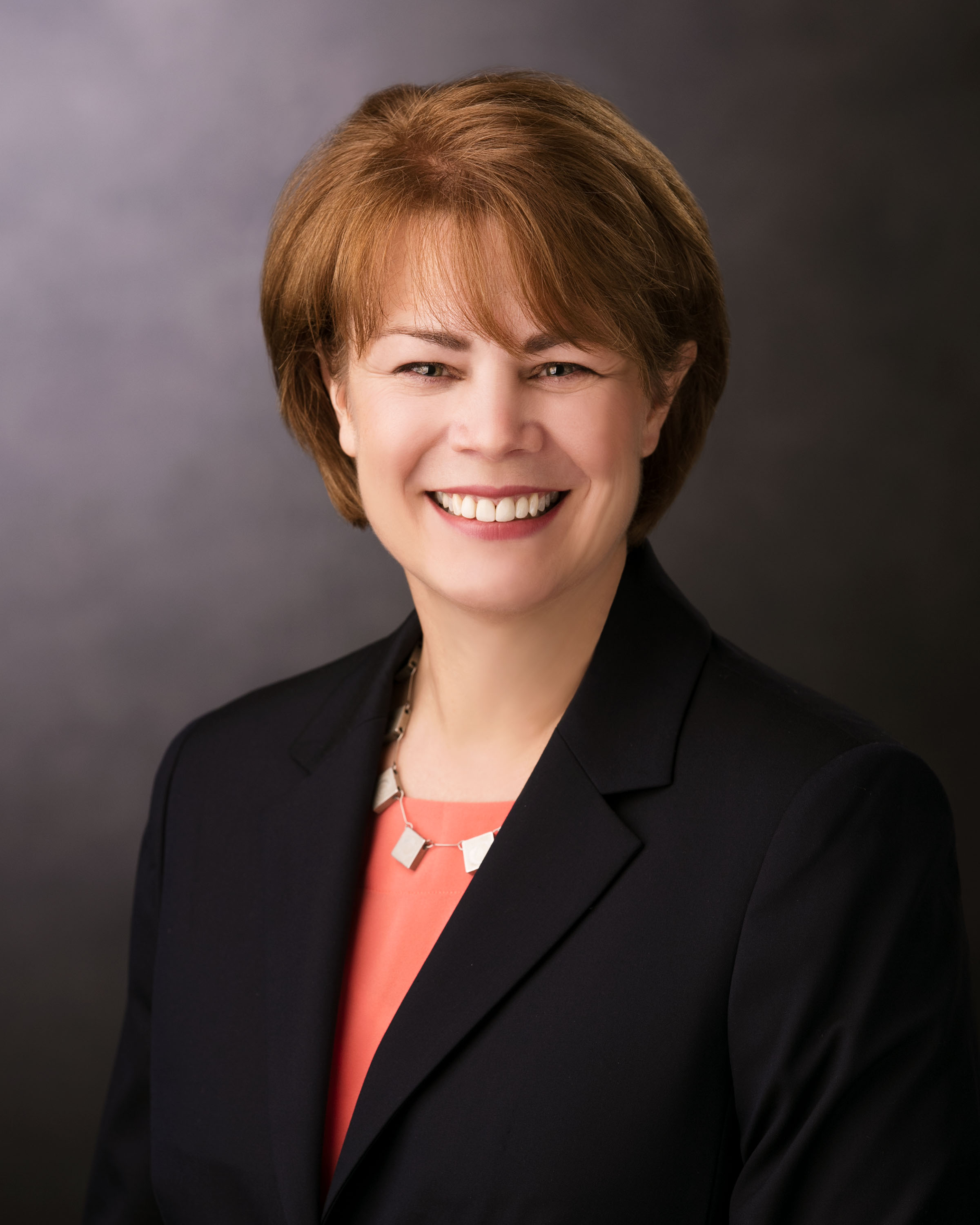 It’s a pleasure to be in this White Chapel in Salt Lake City. I was sitting in the front row on this beautiful hand-carved bench and feeling what it’s like when we’re not removed from the process of how a thing gets made. Wood was cut and split and carved to make this chapel, and you can feel it when you’re here. I feel that way about every piece of creation, whether it is a tree growing out of a patch of soil or whether it is fulfilling the measure of its creation as a pew. I feel that today, and I want to feel it more than I do.
It’s a pleasure to be in this White Chapel in Salt Lake City. I was sitting in the front row on this beautiful hand-carved bench and feeling what it’s like when we’re not removed from the process of how a thing gets made. Wood was cut and split and carved to make this chapel, and you can feel it when you’re here. I feel that way about every piece of creation, whether it is a tree growing out of a patch of soil or whether it is fulfilling the measure of its creation as a pew. I feel that today, and I want to feel it more than I do.
This evening, I thought I would share what I consider to be the intersection between humanitarian work—the subject I live and breathe every single day—and earth stewardship, which all of us here tonight care so much about. The conversations on this topic have become polarized, easily devolving into politics represented by two cable channels. That is a shame. What is useful to me would be to find new ways of discussing the subjects of how to protect and care for the planet where we live in ways many more people can engage with. For example, Dr. Paul Cox at Brigham Young University has created a biographical documentary which provides a new framework to talk about environmental issues in terms of someone’s life story. I think we need different frameworks because the old frameworks don’t work; they just polarize the room and we no longer have the ability to speak about things that we want to, things that are moderate, and that utilize the foundations we have in common. I hope to do some of that tonight.
Imagine you are Joseph Smith in 1830. You have just gone to all the effort to publish the Book of Mormon and officially incorporate the Church. You have a steady stream of people coming to your farm, wanting to see the gold plates or to meet a prophet of God or to ask questions about the Church. You’ve sent out missionaries, including your brothers, and people are starting to respond, get baptized, and join the Church. You know from prophetic vision that the gospel has to fill the whole earth because it is preparatory for the second coming of Jesus Christ. So, once you have established the Church in 1830, what would you do next? Joseph decides to translate the Old Testament—and I ask myself, “Wow! That’s the first thing you decide to do?” He starts with Genesis, and we get the Book of Moses in the Pearl of Great Price from this retranslation or visionary rewrite of the beginning chapters of the Old Testament.
Why was that the first thing Joseph did? Why was that the first thing the Lord inspired him to do in the restoration process after the Church was organized? I believe that the experiences of Moses and of Enoch were of such value to the latter-day mission of this Church that it was critical for us to have the 8 chapters of Moses in the Pearl of Great Price. Later this evening I will read from Moses 7, because I think it has so much to do with where we are today.
I recently prepared a short presentation for the Quorum of the Twelve and the First Presidency about global migration and displacement, and I want to share a few slides with you because there are some statistics here that help us envision the scope of what is currently happening. There are 244 million1 migrants who have left their home country and gone to live someplace else. 70.8 million2 people (inside their own countries or outside) are forcibly displaced: they didn’t want to leave, but war, violence, environmental pressures, or persecution forced their departure. 13.6 million3 of those forcible displacements were new in 2018. The scope of what we are seeing with displacement has not been seen since World War II.4 We get used to hearing these statistics because news and political opinion makers keep talking about them, but the scope of what is happening—the disruption to human behavior, human economies, and human families—is unprecedented. This is why you will hear United Nations officials groping for words to express the unusualness of what is going on. The world is trying to respond to five or six refugee crises at the same time, which has never happened before. 5
People are leaving their homes because their survival as a family is threatened. These threats center on economic pressures, socio-political burdens, and environmental factors. Economic and employment opportunities determine your ability to provide for yourself or your family. Socio-political factors that pressure people to relocate can include warfare or the threat of conflict, slavery or human trafficking, and ethnic, religious, racial, or cultural persecution. The threats of corruption and exploitation are compounded along the dangerous journey of relocation. Simply wanting economic opportunity in the United States isn’t enough of a draw to drive most families to take on such risk. Many of them are fleeing violence and crime, often perpetrated by powerful gangs. Families are facing terrible choices. A gang member will say to a little 10 year old girl, “I want you to be my girlfriend.” Or they'll say to a 9 year old boy, “Come and work for me.” If they don't comply, then the family is burned out of their house or people disappear. “You don’t migrate now in search of the American dream,” these families say, “You go for your life.”6 Sadly, we're seeing a great deal more of this than we have in the past.
In addition to the pressures I’m describing, there are the environmental factors. There are longer-term environmental changes happening that increase displacement. For me, whether we agree on the causes of the environmental changes, is almost beside the point. The loss or decreased productivity of farmland is driving five- and six-generation families off of their lands. Rising seas mean water scarcity from saltwater intrusion is a problem along many coastal regions. This is affecting places like New Jersey, New York, and Amsterdam, but it is most troublesome in the Pacific, where saltwater intrusion is affecting agriculture in a major way. The populations at risk from rising sea levels are high density populations. For example, the Mekong Delta is one of the most populated places in the world and is at risk for major sea intrusion over the next 15 to 20 years.7 People all along the coast of India and across the South Pacific are already being affected by rising seas. In addition to saltwater intrusion and loss of farmland, droughts are getting more severe. Now, I come from a weather family and they can get jiggy about weather extremes, but we really are seeing stronger hurricanes, more intense flooding, and rain that doesn't come for a long time and when it does come, there’s a damaging downpour.8 For example, there have always been cyclical droughts in sub-Saharan Africa, but they are lasting longer and are more intense. These extreme weather patterns are driving a large segment of the migration we are seeing. A New York Times article entitled “Heat, Hunger, and War Force Africans Onto a ‘Road on Fire’” explains how African migrants cross the dangerous Sahara Desert to get up to Libya or Tunisia for a chance at taking a leaky boat across the water to land on the shores of Europe for the chance of being admitted somewhere for asylum.9 No one makes that perilous journey lightly.
There are severe humanitarian implications in these journeys. As people move from one place to another, unlimited need bumps up against finite resources. This is what the United Nations is grappling with: they don't have the resources to deal with the pressures the way they had in the past. They are looking for new sources of funding and new people who will, in a grassroots kind of way, get involved in ways that are new. People are forced to move, and in transit they are suffering violence and death in ways make it hard for me to sleep at night. These situations aren't resolved in one or two years. The Syrian conflict, for example, is going into its eighth year, with increasing conflict outside its borders. 6.8 million Syrians have been displaced outside Syria’s borders. Many more are displaced within Syria. Millions have relocated—enough that a quarter of the population in Jordan and third of the population in Lebanon are now refugees from neighboring conflicts. Think of the pressures this migration exerts on the host countries’ water supplies, infrastructure, sanitation, education system and in many other ways. Their infrastructure was not built to anticipate that the national population would jump by 25% in just a year or two.
Protracted situations mean long-term needs must be considered. While sometimes there are opportunities for people to return home and rebuild their communities, there are devastating cases that don’t end with that option. Some of the areas recently liberated from Islamic State terrorists, such as Mosul, are a good example. What used to be the second largest city in Iraq was made largely uninhabitable by the Islamic State. Facing an advancing army, its soldiers poisoned every water source, booby-trapped every hospital, cut every copper wire, smashed everything that was technical, and generally ensured that Mosul’s infrastructure could not be used again in any way. To those returning to rebuild, they will have to start from the Stone Age to build up an ancient city again. Many will never be able to return in their lifetime. Their situations highlight the necessity of integrating many displaced people into their host communities for long periods of time. I think I read statistics yesterday that said only 97,000 of the 70 million people have been resettled into permanent situations in the West, specifically within the United States or Europe. Most of them are still living in temporary communities, trying to figure out, “How do I get into school? How do I get along in social settings where I speak a different language? I'm from a different place and belong to a different religion, will I be accepted?” This is vividly seen in a Southeast Asia situation where a Muslim minority was expelled largely because of their faith. They are not wanted over the border where they are temporarily staying, and are not welcome to return to their home communities where they have lived for generations. Long term solutions must be found before a generation is lost to scarcity and poverty.
However difficult and intractable these situations can be, opportunities are tremendous for personal service by individuals. President Nelson in this recent General Conference encouraged us to find ways to live our personal religion, to show that we believe in God the Eternal Father and in the brotherhood of man by trying to keep the two great commandments—to love God and to love our neighbor.10 The opportunity is ripe for each one of us to take a cause that we care about and do something helpful that we have not been doing. I believe it will be individuals and families trying to keep the two great commandments that will move this world forward toward the second coming.
I am always thinking about addressing the root causes of displacement, and one of those root causes is environmental degradation. The poor feel the effects first and perhaps most keenly, but these are pressures that affect us all. So, when I got this invitation from Rebecca, I said, “Yes! I want to come talk about that, and I want to come talk about it with people who feel passionately about action.” So, I appreciate the opportunity to be here with you.
Let me now read a few verses out of Moses 7, and I want you to think about what this vision would mean if it were happening to you:
And it came to pass that Enoch looked upon the earth; and he heard a voice from the bowels thereof, saying: Wo, wo is me, the mother of men; I am pained, I am weary, because of the wickedness of my children. When shall I rest, and be cleansed from the filthiness which is gone forth out of me? When will my Creator sanctify me, that I may rest, and righteousness for a season abide upon my face?
And when Enoch heard the earth mourn, he wept, and cried unto the Lord, saying: O Lord, wilt thou not have compassion upon the earth?
And the Lord said: . . . I am Messiah, the King of Zion, the Rock of Heaven, which is broad as eternity; whoso cometh in at the gate and climbeth up by me shall never fall; wherefore, blessed are they of whom I have spoken, for they shall come forth with songs of everlasting joy.
And it came to pass that Enoch cried unto the Lord, saying: When the Son of Man cometh in the flesh, shall the earth rest? I pray thee, show me these things.
And the Lord said unto Enoch: As I live, even so will I come in the last days, in the days of wickedness and vengeance, to fulfil the oath which I have made unto you concerning the children of Noah;
And the day shall come that the earth shall rest, but before that day the heavens shall be darkened, and a veil of darkness shall cover the earth; and the heavens shall shake, and also the earth; and great tribulations shall be among the children of men, but my people will I preserve;
And righteousness will I send down out of heaven; and truth will I send forth out of the earth, to bear testimony of mine Only Begotten; . . . that my people may gird up their loins, and be looking forth for the time of my coming; for there shall be my tabernacle, and it shall be called Zion, a New Jerusalem.
And the Lord said unto Enoch: Then shalt thou and all thy city meet them there, and we will receive them into our bosom, and they shall see us; and we will fall upon their necks, and they shall fall upon our necks, and we will kiss each other;
And there shall be mine abode, and it shall be Zion, which shall come forth out of all the creations which I have made; and for the space of a thousand years the earth shall rest.
. . . And the Lord blessed the land, and they were blessed upon the mountains, and upon the high places, and did flourish.
And the Lord called his people Zion, because they were of one heart and one mind, and dwelt in righteousness; and there was no poor among them.11
As a Relief Society leader, I think how we--Relief Societies and Elders Quorums--are charged with the work of salvation; we share the stewardship of preparing the earth and its people to create this state of Zion, defined as: one heart, one mind, dwelling in righteousness, and no poor among us. Now what does creating Zion and being of one heart and one mind have to do with caring for the earth? I don't have the answer to this, I'm sincerely asking you. I want to think about this question. What is the linkage? Rebecca [director of LDS Earth Stewardship] mentioned earlier that some people will say, “Isn't there something more important to do? Shouldn't we be caring for the poor versus caring for the Earth?” And my question is, are they not linked so inextricably that we can't do one without caring for the other?
While you're thinking about that, I want to show some photos and quotes—and I think these will be meaningful because I just saw that a group from LDS Earth Stewardship was down in Zion National Park for a service project. Casey Jones, the assistant director of Outreach and Development at Zion National Park, sent me some stories I thought I would share with you. As I read them, think about these quotes not as if they're about Zion National Park but as if they're about the actual Zion.
First is a photo I took of the Great Salt Lake from the western side of Antelope Island. I can see this island from my house and when the sun is setting behind it that’s pretty much Zion to me.
Isaac Behunin was a pioneer. He built a log cabin and started a farm exactly where Zion's Lodge sits today. At some point, he was reading the Bible and came across Isaiah 2:2, which reads, “And it shall come to pass in the last days, that the mountain of the Lord's house shall be established in the top of the mountains, and shall be exalted above the hills; and all nations shall flow unto it.” Behunin had lived through the persecutions of Nauvoo of being driven from place to place, and this home, this canyon, this last haven, felt like his Zion. Among God's towering temples, he found refuge and called it Zion—so that's where the park got its name. (Brigham Young didn't like the name because he wanted something else, but when he finally went down there and saw it, he agreed to call it Zion.) Behunin’s quote reads, “A man can worship God among these great cathedrals as well as he can in any man-made church; this is Zion.”12
We have a physical reaction when we are in nature. Sometimes it's overwhelmingly strong when we are in a place like Zion National Park, or putting our hands in the soil, or even riding a bike out on a bike path (thanks to our friend Sarah Bateman in Utah County). When we are out in nature, we feel the spirit of it. I believe the spirit comes from the obedience of Creation. All of nature—the rocks, the mountains, the ocean—will line up at the command of God, and will rearrange itself in whatever way He directs. We are the only beings to whom He has given full agency to choose what we do. So, when we are in nature, we feel the obedience of it to its Creator, and it touches us; we feel it in our hearts.
The second person I want to tell you about is Frederick Dellenbaugh. He was with Major John Wesley Powell and Jacob Hamblin on the second expedition to explore the Colorado River, traveling in canoes. As they went through Zion, Dellenbaugh was blown away by what he was seeing. He vowed to return, and he followed through 27 years after the expedition. In 1903, he gathered up his paints, got a horse, and spent the entire spring, summer, and fall going through what is now Zion National Park and painting. In 1904, at the World's Fair in St Louis, he exhibited some of these paintings. People didn't think the scenery was real. They thought it was fake! Nonetheless, Dellenbaugh’s paintings and an article he authored in Scribner’s Magazine, were a significant influence on President Taft’s decision to declare Mukuntuweap National Monument, which was later renamed Zion. This quote is from that Scribner Magazine article:
“Away below, sage-covered slopes extend to the distant green of Virgin City, overshadowed by the towering magnificence of the Great Temple, standing unique, sublime, adamantine. One hardly knows just what to think of it. Never before has such a naked mountain of rock entered into our minds! Without a shred of disguise its transcendent form rises preeminent. There is almost nothing to compare to it—Niagara has the beauty of energy; the Grand Canyon, of immensity; the Yellowstone, of singularity ; the Yosemite, of altitude; the ocean, of power; this Great Temple, of eternity— . . . Storm, night, the stars, the sun and moon, the elements, alone hold communion with that pristine crest. . . . in all that wondrous expanse of magnificent precipices we hear no sound save our own voices and the whisper of the wind that comes and goes, breathing with the round of centuries. . . . The whole marvellous landscape circled around us now in one immense sweep, weird and wild to the last degree, with apparently no human life but ours within the vast radius of our vision. Mountain, canyon, cliff, pinnacle, valley, and temple stood forth, naked as in those first hours when lifted out of the enveloping seas; a wonderful, an appalling wilderness, of which Little Zion, the Opalescent Valley, is the heart and culmination.” 13
He was moved; those are beautiful words.
Two final quotes. One is from Elder Stephen Richards. This comes from a general conference report in 1940, published in the Improvement Era. He is speaking of Zion National Park but think about it as if it is the real Zion: “[I]t is a sermon—inspiring, exalting, lifting man from the baser things in life to the nobler. . . . His vision is enlarged, his sympathies are broadened, his love of his fellow-men is deepened and his trust in God and the universe is supreme. He is made a better man.”14
The last is from President Russell M. Nelson. “As beneficiaries of the divine Creation, what shall we do? We should care for the earth, be wise stewards over it, and preserve it for future generations. And we are to love and care for one another.”15
I’ve probably read too much, but expressed in these literary and prophetic words is the spirit we feel when we are in nature. It makes us better people; it raises and lifts our spirits so that we treat ourselves and our fellow beings differently. Going back to Moses, recall how Jesus said, “I am Messiah, the King of Zion, the Rock of Heaven, which is broad as eternity”.16 In the same chapter, I find it very interesting that it says about Enoch:
“And it came to pass that the Lord spake unto Enoch, and told Enoch all the doings of the children of men; wherefore Enoch knew, and looked upon their wickedness, and their misery, and wept and stretched forth his arms, and his heart swelled wide as eternity.” 17
His heart swelled wide as eternity. My question is: if Jesus Christ is the King of Zion and as broad as eternity, and Enoch—when he was in the presence of Jesus—felt so much compassion for the earth and its inhabitants that his own heart swelled as wide as eternity, then what would it take for each of us to have our hearts swell as wide as eternity? What vision would encompass us enough so that we could truly have one heart and one mind and dwell in righteousness and have no poor among us?
I ask you seriously and thoughtfully to consider the question: what does Zion have to do with stewardship of the Earth? I will volunteer to come back and listen to a discussion or a panel or anything you want to organize at some future time if you will think about the questions I am asking. I want to hear from you, not as an assignment but because I care so deeply about the potential answers.
First question: When we waste what others desperately need, what are the ramifications to our physical hearts and our unity? This is a difficult question for people who live in what we call First World countries because it's almost impossible not to waste things. Yet our Lord and God, as the Creator, wastes nothing; His system has no waste. When we waste what others desperately need, what does that do to the fabric that stretches between us as human beings?
Second question: I told you earlier a bit about why I think we feel the spirit of God in His creations. In our own creations, what do other people feel? We honored Sarah Bateman with an award this evening because of some of her unique creations and how they make us feel. When we look at our own creations or the creations we are a part of, how do we feel? What feelings flow from what we are creating?
And the third question: What would move our hearts? How could we frame the discussion so that we would stop having the same unsuccessful conversation over and over again? What would move our hearts to swell as wide as eternity so that we would act, we would use our will, we would do something new for the benefit of humankind?
If you will indulge me—you are all as good as a choir in this building. There is no piano and I don't play the organ but, as my closing testimony, would you sing a capella with me these three great verses of “Guide Us, O Thou Great Jehovah”? Pour your heart into it, and we can lift the roof off of this chapel.
1. Guide us, O thou great Jehovah,
Guide us to the promised land.
We are weak, but thou art able;
Hold us with thy pow'rful hand.
Holy Spirit, Holy Spirit,
Feed us till the Savior comes,
Feed us till the Savior comes.
2. Open, Jesus, Zion's fountains;
Let her richest blessings come.
Let the fiery, cloudy pillar
Guard us to this holy home.
Great Redeemer, Great Redeemer,
Bring, oh, bring the welcome day,
Bring, oh, bring the welcome day!
3. When the earth begins to tremble,
Bid our fearful thoughts be still;
When thy judgments spread destruction,
Keep us safe on Zion's hill,
Singing praises, Singing praises,
Songs of glory unto thee,
Songs of glory unto thee.18
These words are my testimony. I don't know exactly what to do but I'm committed to waking up every day and trying to put some action into my beliefs. I pray that Jehovah, the God of the Old Testament, who is also Jesus Christ, the Messiah of the New Testament, will guide me so that little tiny drops of action can somehow flow together into a small stream that joins a bigger river that flows into the ocean and finally create Zion. All of us can be part of that.
May God bless your work. In the name of Jesus Christ, amen.
——————————————————————————————————————————
1 https://www.who.int/migrants/en/
2 https://www.unhcr.org/en-us/news/press/2019/6/5d03b22b4/worldwide-displacement-tops-70-million-un-refugee-chief-urges-greater-solidarity.html
3 https://www.unhcr.org/ph/figures-at-a-glance
4 https://www.cnn.com/2016/06/20/world/unhcr-displaced-peoples-report/index.html
5 https://www.unhcr.org/en-us/figures-at-a-glance.html
6 https://www.nytimes.com/2016/11/13/world/americas/fleeing-gangs-central-american-families-surge-toward-us.html
7 https://www.nature.com/articles/s41467-019-11602-1
8 https://www.dw.com/en/climate-change-and-extreme-weather-science-is-proving-the-link/a-43323706
9 https://www.nytimes.com/interactive/2016/12/15/world/africa/agadez-climate-change.html
10 President Russell M. Nelson “Love Thy Neighbor” General Conference report, Ensign, November 2019
11 Moses 7:48-49, 53-54, 60-64, and 17-18
12 Isaac Behunin, quoted in “Zion National Park, Utah,” Steve Chapman, Chicago Tribune, Aug 14, 2014
13 https://archive.org/stream/scribnersmagazin35newy/scribnersmagazin35newy_djvu.txt
14 Stephen L. Richards Conference Report, Apr. 1940; “Avocation,” Improvement Era, June 1927
15 Russell M. Nelson “The Creation,” Ensign, May 2000, 84.
16 Moses 7:53
17 Moses 7:41
18 LDS Hymns, 83
Fall Forum 2019: Preparing for Zion and Stewardship of the Earth are Inextricably Linked
The tone for our Fall Forum was set by the historic and venerable location of White Memorial Chapel. Every pew and seat were filled by eager listeners, ready to hear what Sister Sharon Eubank came to share. After introducing our Board of Directors, presenting the Steward of the Year award, sharing highlights from the past year, and announcing the Duty, Love and Stewardship campaign, the majority of the evening was left to our special guest.
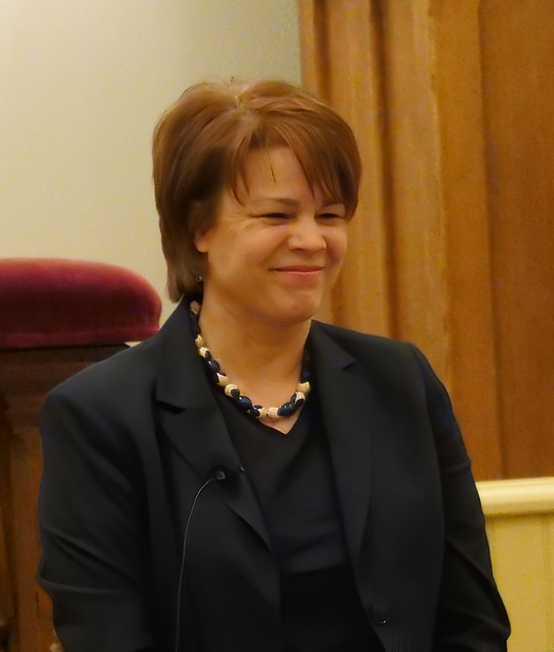 Sister Eubank opened graciously, explaining that she hadn't written down her thoughts because she wanted to have a conversation. Her first topic was how humanitarian work and environmental stewardship intersect: the migration of displaced people. Environmental degradation is one of the top three reasons that people leave their home. Long-term environmental changes such as saltwater intrusion from rising sea levels and increasingly extreme weather patterns like droughts and hurricanes force desperate departures that are perilous and risky. Sis. Eubank pointed out that the scale of the migration happening right now hasn't been seen since World War II. Naturally, our response needs to cover the immediate needs of the displaced, but it's equally important to address the root causes of migration—which include environmental concerns.
Sister Eubank opened graciously, explaining that she hadn't written down her thoughts because she wanted to have a conversation. Her first topic was how humanitarian work and environmental stewardship intersect: the migration of displaced people. Environmental degradation is one of the top three reasons that people leave their home. Long-term environmental changes such as saltwater intrusion from rising sea levels and increasingly extreme weather patterns like droughts and hurricanes force desperate departures that are perilous and risky. Sis. Eubank pointed out that the scale of the migration happening right now hasn't been seen since World War II. Naturally, our response needs to cover the immediate needs of the displaced, but it's equally important to address the root causes of migration—which include environmental concerns.
The second topic centered around Zion. Sis. Eubank highlighted the strange choice that Joseph Smith made after establishing the Church; of all the things he could have put his time and effort into, Joseph translated the Old Testament. She proposed that it indicates how important the experiences of Moses and Enoch are. After reading some of the verses in Moses 7, she asked us to seriously and thoughtfully consider what preparing the earth to be Zion—of one heart and one mind, dwelling in righteousness with no poor among us—has to do with stewardship of the earth. "Are they not linked so inextricably that we can't do one without caring for the other?" she asked.
For her testimony, Sis. Eubank closed by leading the attendees in singing Guide Us, O Thou Great Jehovah. The Spirit swelled with the sound of beautiful voices. After finishing, she added, "I pray that Jehovah . . . will guide me so that little tiny drops of action can somehow flow together . . . and finally create Zion." She acclaimed the work of LDS Earth Stewardship by lauding our Resource Library, appreciating how we stay true to Church teachings, and explaining that her attendance at this forum was approved by Church leadership. "There is no question: we are stewards of the earth and we care for the earth," she affirmed, "It is a godly and holy work."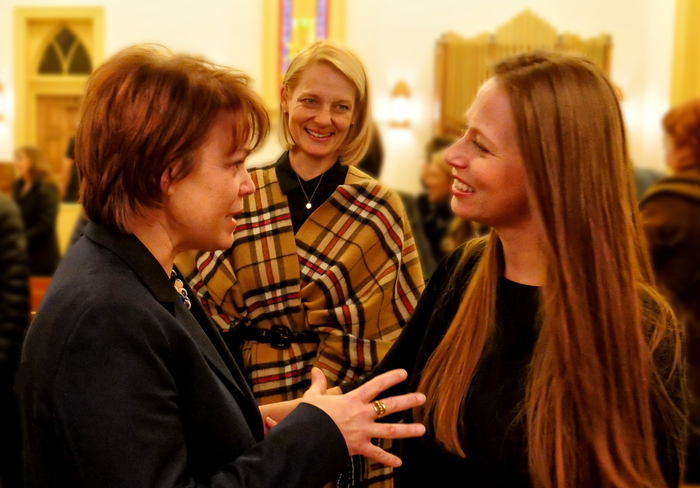
With hope of continuing the conversation at future events, she asked three questions that she wants us to help her answer. We list them below, with some context from the evening’s discussion, for you to ponder:
1. When we waste what others desperately need, what physically happens to unity and our hearts?
Reflecting on the hand-carved pews we sat upon in the chapel, Sis. Eubank brought attention to how it feels when we're familiar with the process of how something is made. She expressed the weighty seriousness of wastefulness by tracing the "value chain" of resources required to get a package of raspberries into her fridge. We are indefensibly culpable when we waste something that could have benefitted someone else; if we all reduced our waste, we could fulfill many of the needs of our poor without even sacrificing. When we look at the processes that God designed in the natural world, there is no waste; that is a divine pattern.
2. Why do we feel God in His creations? What do others feel in our own creations?
In discussing Zion, Sis. Eubank shared a handful of quotes about individuals' experiences in Zion National Park. They all touched on the physical reactions and deep feelings that come from being in nature. One possible explanation for this phenomenon Sis. Eubank suggested is that the obedience of the natural world to its Creator has an uplifting influence. In her words, "It makes us better people; it raises and lifts our spirits so that we treat ourselves and our fellow beings differently."
3. What would move our hearts to swell "as wide as eternity" (Moses 7:41)?
Noting that the way we often talk about environmental issues is polarizing, Sis. Eubank identified the need for a new framing that can open the conversation up again. However, she warned that the position of a ‘moral high horse’ is unlikely to be constructive. Instead she encouraged creative persuasions that appeal to others’ practicality and humor. Because “we are the Church,” we don’t need to wait for Church leaders to give direction before enacting eco-friendly practices in our wards and stakes.
The transcript was first shared with the members of LDSES via the newsletter,
but is now freely available to read here.
